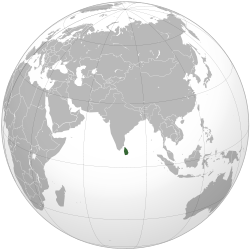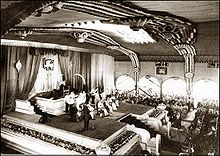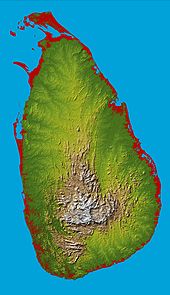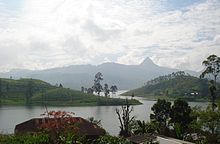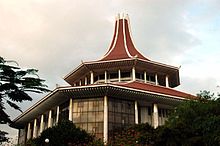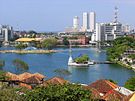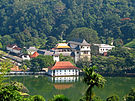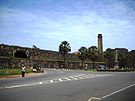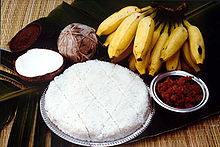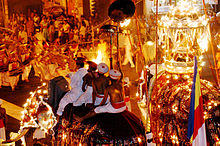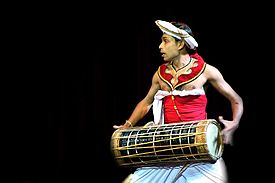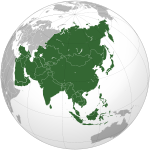- Sri Lanka
-
"Ceylon" redirects here. For the time period of 1948-1972, see Dominion of Ceylon. For other uses, see Ceylon (disambiguation).
Democratic Socialist
Republic of Sri Lankaශ්රී ලංකා ප්රජාතාන්ත්රික සමාජවාදී ජනරජය (Sinhala) இலங்கை சனநாயக சமத்துவ குடியரசு (Tamil) 

Flag Emblem Anthem:
Sri Lanka Matha
Mother Sri LankaCapital Sri Jayawardenapura-Kotte[1][2]
6°54′N 79°54′E / 6.9°N 79.9°ELargest city Colombo Official language(s) Sinhala, Tamil Demonym Sri Lankan Government Democratic Socialist Republic, Semi-presidential system - President Mahinda Rajapaksa - Prime Minister D. M. Jayaratne - Speaker of the House Chamal Rajapaksa - Chief Justice Dr. Shirani Bandaranayake Independence from the United Kingdom - Dominion (Self rule) February 4, 1948 - Republic May 22, 1972 Area - Total 65,610 km2 (122nd)
25,332 sq mi- Water (%) 4.4 Population - 2010 estimate 20,238,000[3] (56th) - Mid 2010 census 20,653,000[4] - Density 308.4/km2 (35th)
798.9/sq miGDP (PPP) 2010 estimate - Total $106.5 billion[5] (65th) - Per capita $5,220[5] GDP (nominal) 2010 estimate - Total $49.68 billion[5] (73rd) - Per capita $2,435[5] Gini (2010) 36[6] (medium) HDI (2011)  0.691[7] (medium) (97th)
0.691[7] (medium) (97th)Currency Sri Lankan Rupee ( LKR)Time zone Sri Lanka Standard Time Zone (UTC+5:30) - Summer (DST) not observed (UTC) Date formats yyyy/mm/dd (AD) Drives on the left ISO 3166 code LK Internet TLD .lk, .ලංකා, .இலங்கை Calling code 94 Sri Lanka, officially the Democratic Socialist Republic of Sri Lanka (
 i/ʃriː ˈlɑːŋkə/, /sriːˈlɑːŋkə/, or /sriːˈlæŋkə/;[8][9] Sinhala: ශ්රී ලංකා, Tamil: இலங்கை) is a country off the southern coast of the Indian subcontinent. Known until 1972 as Ceylon (
i/ʃriː ˈlɑːŋkə/, /sriːˈlɑːŋkə/, or /sriːˈlæŋkə/;[8][9] Sinhala: ශ්රී ලංකා, Tamil: இலங்கை) is a country off the southern coast of the Indian subcontinent. Known until 1972 as Ceylon ( /sɨˈlɒn/, /seɪˈlɒn/, or /siːˈlɒn/), Sri Lanka is an island surrounded by the Indian Ocean, the Gulf of Mannar and the Palk Strait, and lies in the vicinity of India and the Maldives. It is part of South Asia.
/sɨˈlɒn/, /seɪˈlɒn/, or /siːˈlɒn/), Sri Lanka is an island surrounded by the Indian Ocean, the Gulf of Mannar and the Palk Strait, and lies in the vicinity of India and the Maldives. It is part of South Asia.As a result of its location in the path of major sea routes, Sri Lanka is a strategic naval link between West Asia and South East Asia.[10] It was an important stop on the ancient Silk Road.[11] Sri Lanka has also been a center of the Buddhist religion and culture from ancient times and is one of the few remaining abodes of Buddhism in South Asia along with Ladakh, Bhutan and the Chittagong hill tracts.[12] The Sinhalese community forms the majority of the population; Tamils, who are concentrated in the north and east of the island, form the largest ethnic minority. Other communities include Moors, Burghers, Kaffirs, Malays and the aboriginal Vedda people.[13]
Sri Lanka is a republic and a unitary state which is governed by a semi-presidential system with its official seat of government in Sri Jayawardenapura-Kotte, the capital. The country is famous for the production and export of tea, coffee, coconuts, rubber and cinnamon, the last of which is native to the country.[14] The natural beauty of Sri Lanka has led to the title The Pearl of the Indian Ocean.[15] The island is laden with lush tropical forests, white beaches and diverse landscapes with rich biodiversity. The country lays claim to a long and colorful history of over three thousand years, having one of the longest documented histories in the world.[16] Sri Lanka's rich culture can be attributed to the many different communities on the island.[17]
Sri Lanka is a founding member state of SAARC and a member United Nations, Commonwealth of Nations, G77 and Non-Aligned Movement. As of 2010, Sri Lanka was one of the fastest growing economies of the world. Its stock exchange was Asia's best performing stock market during 2009 and 2010.[18]
Contents
Etymology
Main article: Names of Sri LankaIn ancient times, Sri Lanka was known by a variety of names: Known in India as Lanka or Singhala, ancient Greek geographers called it Taprobane[19]
 /təˈprɒbəniː/ and Arabs referred to it as Serendib (the origin of the word "serendipity").[20] Ceilão was the name given to Sri Lanka by the Portuguese when they arrived in 1505,[21] which was transliterated into English as Ceylon.[22] As a British crown colony, the island was known as Ceylon, and achieved independence under the name Dominion of Ceylon in 1948.
/təˈprɒbəniː/ and Arabs referred to it as Serendib (the origin of the word "serendipity").[20] Ceilão was the name given to Sri Lanka by the Portuguese when they arrived in 1505,[21] which was transliterated into English as Ceylon.[22] As a British crown colony, the island was known as Ceylon, and achieved independence under the name Dominion of Ceylon in 1948.In Sinhala the country is known as ශ්රී ලංකා śrī laṃkā, IPA: [ʃɾiːˈlaŋkaː], and the island itself as ලංකාව laṃkāva, IPA: [laŋˈkaːʋə]. In Tamil they are both இலங்கை ilaṅkai, IPA: [iˈlaŋɡai]. The name derives from the Sanskrit श्री लंका śrī (venerable) and lankā (island),[23] the name of the island in the ancient Indian epics Mahabharata and the Ramayana. In 1972, the official name of the country was changed to "Free, Sovereign and Independent Republic of Sri Lanka". In 1978 it was changed to the "Democratic Socialist Republic of Sri Lanka".[24] The name Ceylon is still in use in the names of a number of organisations; in 2011, the Sri Lankan government announced a plan to rename all of those for which it is responsible.[25]
History
Main article: History of Sri LankaPre-historic Sri Lanka
Main article: Prehistory of Sri LankaThe pre-history of Sri Lanka dates back over 125,000 years Before Present (BP) and possibly even as early as 500,000 BP.[26] The era spans the Palaeolithic, Mesolithic and early Iron ages. Among the Paleolithic (Homo Erectus) human settlements discovered in Sri Lanka, Pahiyangala (named after the Chinese traveler monk Fa-Hsien), which dates back to 37,000 BP,[27] Batadombalena (28,500 BP)[28] and Belilena (12,000 BP) are the most important. The remains of Balangoda Man, an anatomically modern human, found inside these caves,[29] suggests that they may have engaged in agriculture and kept domestic dogs for driving game.[30]
One of the first written references to the island is found in the Indian epic Ramayana, which provides details of a kingdom named Lanka that had been created by the divine sculptor Vishwakarma, for Kubera, the lord of wealth.[31] It is said that in 2370 BC, Kubera was overthrown by his demon stepbrother Ravana, the powerful Emperor who built a mythical flying machine named Dandu Monara.[32] The modern city of Wariyapola is described as Ravana's airport.[33]
Ravana belonged to the aboriginal inhabitant tribe Raksha, which lived alongside four Hela tribes named Yaksha, Deva, Naga and Gandharva.[34] These early inhabitants of Sri Lanka were probably the ancestors of the Vedda people,[35] an indigenous community living in modern-day Sri Lanka, which numbers approximately 2,500. Irish historian James Emerson Tennent theorised Galle, a southern city in Sri Lanka, was the ancient seaport of Tarshish, from which King Solomon is said to have drawn ivory, peacocks and other valuables. Early inhabitats of the country spoke the Elu language, which is considered the early form of the modern Sinhala language.[36]
Ancient Sri Lanka
Main article: Ancient history of Sri LankaAccording to the Mahāvamsa, a chronicle written in Pāli language, the ancient period of Sri Lanka begins in 543 BC,[37] with the landing of Vijaya, a semi-legendary king who arrived in the country with 700 followers from the southwest coast of Bangladesh. After consolidating the power, he established the Kingdom of Tambapanni, near modern day Mannar. Vijaya is the first of the approximately 189 native monarchs of Sri Lanka, as described in various chronicles like Dipavamsa, Mahāvamsa, Chulavamsa and Rājāvaliya. (see List of Sri Lankan monarchs) Sri Lankan dynasty spanned over a period of 2359 years, from 543 BC to 1815 AD, until it came under the rule of British Empire.[38]
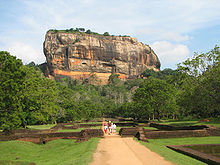 The Sigiriya rock fortress.
The Sigiriya rock fortress.
The Kingdom of Sri Lanka moved to Anuradhapura in 380 BC, during the reign of Pandukabhaya. Since then, Anuradhapura served as the capital of the country for nearly 1400 years.[39] Pandukabhaya built the second irrigation scheme in ancient Sri Lanka, the Abhaya tank (Basawakkulama reservoir).[40] Ancient Sri Lankans excelled in various constructions such as tanks, dagobas and palaces.[41] The Sri Lankan society underwent a major transformation during the reign of Devanampiya Tissa, with the arrival of Buddhism from India. In 250 BC,[42] bhikkhu Mahinda, who is believed to have been the son of the great Mauryan Emperor Ashoka, arrived in Mihintale, carrying the message of Buddhism.[43] Mahinda's mission won over the monarch, who embraced the faith and propagated it throughout the Sinhalese population.[44] The succeeding kingdoms of Sri Lanka would maintain a large number of Buddhist schools and monasteries, and support the propagation of Buddhism into other countries in Southeast Asia as well.[45] In 245 BC, bhikkhuni Sangamitta arrived in Sri Lanka with the Jaya Sri Maha Bodhi tree, which is considered to be a sapling from the historical Bodhi tree under which Gautama Buddha became enlightened.[46] It is considered the oldest tree in the world, with a continuous historical record. (Bodhivamsa)[47]
Sri Lanka experienced the first foreign invasion during the reign of Suratissa, who was defeated by two horse traders named Sena and Guttika from South India.[44] The next invasion came in 205 BC by a Chola king named Elara. He ruled the country for 44 years. Dutugemunu, the eldest son of the southern regional sub-king, Kavan Tissa, defeated Elara in the Battle of Vijithapura. He built the second stupa in ancient Sri Lanka, Ruwanwelisaya and the Lovamahapaya.[48] During its two and half millenias of existence, kingdom of Sri Lanka was invaded at least 8 times by neighbouring South Asian dynastys such as Chola, Pandya, Chera and Pallava.[49] There had also been incursions by the kingdoms of Kalinga (modern Orissa) and from Malay Peninsula as well. Kala Wewa and the Avukana Buddha statue were built during the reign of Dhatusena.[50]
 Claudius Ptolemy's map of Ceylon, first century AD
Claudius Ptolemy's map of Ceylon, first century AD
Sri Lanka was the first Asian country to have a female ruler; Queen Anula who reigned from 47–42 BC.[51] Sri Lankan monarchs have attained some remarkable construction achievements like Sigiriya, the so-called "Fortress in the Sky". It was a constructed during the reign of Kashyapa I. Sigiriya is a rock fortress surrounded by an extensive network of gardens, reservoirs, and other structures. The 5th century palace is also renowned for frescos on the rock the surface.[50] It has been declared by the UNESCO as the 8th Wonder of the world.[52][53] Among the other constructions, large reservoirs, important for conserving water in a climate that alternates rainy seasons with dry times, and elaborate aqueducts, some with a slope as finely calibrated as one inch to the mile are dominant. Biso Kotuwa, a peculiar construction inside a dam, is a technological marvel based on precise mathematics, allowing water to flow outside the dam keeping the pressure to a minimum.[54] Ancient Sri Lanka was the first country in the world to have established a dedicated hospital; in Mihintale in the 4th century.[55] It was also the leading exporter of cinnamon in the ancient world, and has maintained close ties with European civilizations including Roman Empire. For example, King Bhatikabhaya (BC 22 - 7 AD) had sent an embassy to Rome and got down coral for a net to be cast over the Ruwanwelisaya.[56] Bhikkhuni Devasāra and ten other fully ordained bhikkhunis from Sri Lanka had went to China and established the bhikkhuni sāsana there in 429 AD.[46]
Medieval Sri Lanka
Main article: Medieval history of Sri Lanka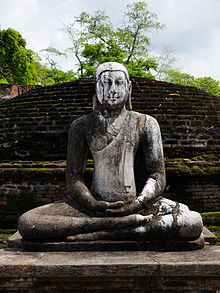 A Buddhist statue in the ancient capital city of Polonnaruwa, 12th century
A Buddhist statue in the ancient capital city of Polonnaruwa, 12th century
The medieval period of Sri Lanka begins with the fall of Anuradhapura. In 993 AD, the invasion of Chola emperor Rajaraja I forced the then Sri Lankan ruler Mahinda V to flee to the southern part of the country.[57] Taking advantage of this situation, Rajendra I son of Rajaraja I, launched a large invasion in 1017 AD. Mahinda V was captured and taken to India, and the Cholas sacked the city of Anuradhapura.[57] Subsequently, they moved the capital to Polonnaruwa.[58] This marked the end of the two great houses of dynasties of ancient Sri Lanka, Moriya and the Lambakanna. Following a seventeen year long campaign, Vijayabahu I successfully drove the Chola out of Sri Lanka in 1070, reuniting the country for the first time in over a century.[59][60] Upon his request, ordained monks were sent from Burma to Sri Lanka to re-establish Buddhism which had almost disappeared from the country during the Chola reign.[61] During the medieval period, Sri Lanka was divided to three sub-territories, namely Ruhunu, Pihiti and Maya.[62]
 Kuttam Pokuna or the Twin Ponds, Anuradhapura, 8th century
Kuttam Pokuna or the Twin Ponds, Anuradhapura, 8th century
Sri Lanka's irrigation system was extensively expanded during the reign of Parākramabāhu the Great (1153–1186 AD).[63] This period is considered as a time when Sri Lanka was at the height of its power.[64][65] He built 1470 reservoirs - highest number by any ruler in the history, repaired 165 dams, 3910 canals, 163 major reservoirs, and 2376 mini reservoirs.[66] His famous construction is the Parakrama Samudra,[67] the largest irrigation project of medieval Sri Lanka. Parākramabāhu's reign is memorable for two major campaigns — in the south of India as part of a Pandyan war of succession, and a punitive strike against the kings of Ramanna (Myanmar) for various perceived insults to Sri Lanka.[68]
After his demise, Sri Lanka gradually decayed in power. In 1215 AD, Kalinga Magha, a South Indian with uncertain origins, invaded and captured the Kingdom of Polonnaruwa with a 24,000 strong army from Kalinga.[66] Unlike the previous invaders, he looted, ransacked and destroyed everything in the ancient Anuradhapura and Polonnaruwa Kingdoms beyond recovery.[69] His priorities in ruling were to extract as much as possible from the land and overturn as many of the traditions of Rajarata as possible. His reign saw the massive migration of native Sinhalese people to the south and west of Sri Lanka, and into the mountainous interior, in a bid to escape his power. Sri Lanka never really recovered from the impact of Kalinga Magha's invasion. King Vijayabâhu III, who led the resistance, brought the kingdom to Dambadeniya. The north, in the meanwhile, eventually evolved into the Jaffna kingdom.[70][71] Jaffna kingdom never came under the rule of the kingdom of south except on one occasion; in 1450, following the conquest led by king Parâkramabâhu VI's adopted son, Prince Sapumal.[72] He ruled the North from 1450 to 1467 AD.[73] The next three centuries stating from 1215 were marked by kaleidoscopically shifting collection of kingdoms in south and central Sri Lanka, including Dambadeniya, Yapahuwa, Gampola, Raigama, Kotte,[74] Sitawaka and finally, Kandy.
Early modern Sri Lanka
Main article: Colonial history of Sri LankaThe early modern period of Sri Lanka begins with the arrival of Portuguese soldier and explorer Lorenzo de Almeida, the son of Francisco de Almeida in 1505.[75] The Portuguese founded a fort at the port city of Colombo in 1517 and gradually extended their control over the coastal areas. In 1592 Vimaladharmasuriya I moved the kingdom to the inland city of Kandy, a location more secure against an attack from western invaders.[76] Intermittent warfare continued through the 16th century. In 1619, due to the attacks of Portuguese, independent existence of Jaffna kingdom, came to an end.[77]
 Colonial Coat of arms of British Ceylon
Colonial Coat of arms of British Ceylon
During the reign of the Rajasinghe II, Dutch explorers arrived in the island. In 1638, the king signed a treaty with the Dutch East India Company to get rid of Portuguese who ruled most of the coastal areas.[78] The following Dutch–Portuguese War resulted in Dutch victory, with Colombo falling into Dutch hands by 1656. Dutch remained in the areas they captured, violating the treaty. An ethnic group named Burgher people integrated into the Sri Lankan society as a result of Dutch rule.[79] The Kingdom of Kandy was the last independent monarchy of Sri Lanka.[80] In 1595, Vimaladharmasurya brought the sacred Tooth Relic - the traditional symbol of royal and religious authority amongst the Sinhalese - to Kandy, and built the Temple of the Tooth.[80] Even with intermittent warfare with Europeans, the kingdom was able to survive. A succession crisis emerged in Kandy, upon king Vira Narendrasinha's death in 1739. He was married to a Telugu-speaking Nayakkar princess from South India and was childless by them.[80] Eventually, with the support of bhikku Weliwita Sarankara, the crown passed to the brother of one of Narendrasinha's princess, overlooking the right of "Unambuwe Bandara", Narendrasinha's own son by a Sinhalese concubine.[81] The new king was crowned Sri Vijaya Rajasinha later that year. Kings of Nayakkar dynasty, launched several attacks on Dutch controlled areas, which proved to be unsuccessful.[82]
During the Napoleonic Wars, fearing that French control of the Netherlands might deliver Sri Lanka to the French, Great Britain occupied the coastal areas of the island (which they called Ceylon) with little difficulty in 1796.[83] Two years later, in 1798, Rajadhi Rajasinha, 3rd of the four Nayakkar kings of Sri Lanka died of a fever. Following the death, a nephew of Rajadhi Rajasinha, 18-year-old Konnasami was crowned.[84] The new king, Sri Vikrama Rajasinha faced a British invasion in 1803, but was able to retaliate successfully. By then, the entire coastal area was under the British East India Company, as a result of the Treaty of Amiens. But on 14 February 1815, Kandy was occupied by the British, in the second Kandyan War, finally ending Sri Lanka's independence.[84] Sri Vikrama Rajasinha, the last native monarch of Sri Lanka was exiled to India.[85] Kandyan convention formally ceded the entire country to the British Empire. Attempts of Sri Lankan noblemen to undermine the British power in 1818 during the Uva Rebellion were thwarted by Governor Robert Brownrigg.[86]
Modern Sri Lanka
Sri Lanka under the British rule
The beginning of the modern period of Sri Lanka is marked by the Colebrooke-Cameron reforms of 1833.[87] They introduced a utilitarian and liberal political culture to the country based on the rule of law and amalgamated the Kandyan and maritime provinces as a single unit of government.[87] An Executive Council and a Legislative Council were established, later becoming the foundation of representative legislature in the country. By this time, experiments with coffee plantation were largely successful. Soon it grew to become the primary commodity export of the country. The falling coffee prices as a result of the depression of 1847 stalled economic development and prompted the governor to introduce a series of taxes on firearms, dogs, shops, boats, etc., and reintroduce a form of rajakariya, requiring six days free labour on roads or payment of a cash equivalent.[88] These harsh measures antagonized the locals, and another rebellion broke out in 1848.[89] A devastating leaf disease, Hemileia vastatrix, struck the coffee plantations in 1869, destroying the entire industry within 15 years. The British officials desperately searched for a substitute, and the promising replacement they found was tea. Production of tea in Sri Lanka thrived within the decades to come.
By the end of the 19th century, a new educated social class which transcended the divisions of race and caste was emerging as a result of British attempts to nurture a range of professionals for the Ceylon Civil Service and for the legal, educational, and medical professions.[90] The country's new leaders represented the various ethnic groups of the population in the Ceylon Legislative Council on a communal basis. In the meantime, attempts were underway for Buddhist and Hindu revivalism and to react against Christian missionary activities on the island.[91][92] The first two decades in the 20th century are distinguished for the harmony that prevailed among Sinhalese and Tamil political leadership, which has not been the case ever since.[93] In 1919, major Sinhalese and Tamil political organizations united to form the Ceylon National Congress, under the leadership of Ponnambalam Arunachalam.[94] It kept pressing the colonial masters for more constitutional reforms. But due to its failure to appeal to the masses and the governor's encouragement for "communal representation" by creating a "Colombo seat" that dangled between Sinhalese and Tamils, the Congress lost its momentum towards the mid 1920s.[95] The Donoughmore reforms of 1931 repudiated the communal representation and introduced universal adult franchise (the franchise stood at 4% before the reforms). This step was strongly criticized by the Tamil political leadership, who realized that they would be reduced to a minority in the newly created State Council of Ceylon, which succeeded the legislative council.[96][97] In 1937, Tamil leader G. G. Ponnambalam demanded a 50-50 representation (50% for the Sinhalese and 50% for other ethnic groups) in the State Council. However, this demand was not met by the Soulbury reforms of 1944/45.
Post independence Sri Lanka
The Soulbury constitution ushered the Dominion status for Ceylon, delivering it independence on 4 February 1948.[98] The office of Prime Minister of Ceylon was created in advance of independence, on 14 October 1947, D. S. Senanayake being the first prime minister.[99] Prominent Tamil leaders like Ponnambalam and A. Mahadeva joined his cabinet.[100][96] Although the country gained independence in 1948, the British Royal Navy stationed at Trincomalee remained until 1956. 1953 hartal, against the withdrawal of the rice ration, resulted in the resignation of the then prime minister, Dudley Senanayake.[101] With the election of S. W. R. D. Bandaranaike to the prime ministership in 1956, Ceylon began moving towards better relations with the communist bloc. Bandaranaike's 3 year rule had a profound impact on the direction of the country. He emerged as the "defender of the besieged Sinhalese culture" and promised radical changes in the system.[102] He introduced the controversial Sinhala Only Act, recognising Sinhala as the sole official language of the government. Although it was partially reversed in 1958, the bill posed a grave concern for the Tamil community, which perceived their language and culture were threatened.[103][104] The Federal Party (FP) launched satyagraha against the move, which prompted Bandaranaike to reach an agreement (Bandaranaike-Chelvanayakam Pact) with S. J. V. Chelvanayakam, leader of the FP, to resolve the looming ethnic conflict.[105] However the pact was not carried out due to protests by opposition and the Buddhist clergy. The bill, together with various government colonisation schemes, contributed much towards the political rancour between Sinhalese and Tamil political leaders.[106] Bandaranaike was assassinated by an extremist Buddhist monk in 1959.[107]
Sirimavo Bandaranaike, the widow of late S. W. R. D. Bandaranaike, took office as prime minister in 1960, but faced an attempted coup d'état in 1962. During the second term as prime minister, her government instituted socialist economic polices, further strengthening ties with the Soviet Union and later China, while promoting a policy of non-alignment. However in 1971, Ceylon experienced a Marxist insurrection, which was quickly suppressed. In 1972, with the adoption of a new constitution, the country became a republic, repudating the Dominion status and changing its name to Sri Lanka. Prolonged minority grievances and the use of communal emotionalism as an election campaign weapon by both Sinhalese and Tamil leaders abetted a fledging Tamil militancy in the north, during 1970s.[108] The policy of standardization by Sirimavo government to rectify disparities created in university enrollment, which was in essence an affirmative action to assist geographically disadvantaged students to gain tertiary education,[109] in turn reducing the number of Tamil students within the Sri Lankan university student populace; acted as the immediate catalyst for the rise of militancy.[110][111] Assassination of Jaffna Mayor Alfred Duraiyappah in 1975 marked an important turn of the events.[112][113]
The Government of J. R. Jayawardene swept to power in 1977, defeating the largely unpopular United Front grovernment, towards its final years.[114] Jayawardene introduced a new constitution, together with a powerful executive presidency modelled after France, and a free market economy. It made Sri Lanka the first South Asian country to liberalise its economy.[115] However from 1983, ethnic tensions blew into on-and-off insurgency (see Sri Lankan Civil War) against the government by the Liberation Tigers of Tamil Eelam (the LTTE, also known as the Tamil Tigers), a militant group emerged in early 1970s. Following the riots in July 1983, more than 150,000 Tamil civillians fled the island, seeking asylum in other countries.[116] Lapses in foreign policy resulted in neighbouring India strengthening the Tigers by providing arms and training.[117][118][119] In 1987, the Indo-Sri Lanka Accord was signed and Indian Peace Keeping Force (IPKF) was deployed in northern Sri Lanka to stabilize the region by neutralising the LTTE.[120] The same year, the JVP launched its second insurrection in Southern Sri Lanka.[121] As their efforts did not become successful, IPKF was called back in 1990.[122]
Sri Lanka was affected by the devastating 2004 Asian tsunami, which left at least 35,000 people dead.[123] From 1985 to 2006, Sri Lankan government and Tamil insurgents held 4 rounds of peace-talks, none of them helping a peaceful resolution of the conflict. In 2009, under the Presidency of Mahinda Rajapaksa the Sri Lanka Armed Forces defeated the LTTE, and re-established control of the entire country under the Sri Lankan Government.[124][125] The 26 year war caused upto 100,000 deaths.[126] Following the LTTE's defeat, Tamil National Alliance, the largest political party in Sri Lanka dropped its demand for a separate state, in favour of a federal solution.[127][128] The final stages of the war left some 294,000 people displaced.[129][130] According to the Ministry of Resettlement, most of the displaced persons had been released or returned to their places of origin, leaving only 7,440 in the camps as of August 2011.[131] Sri Lanka, emerging after a 26 year war, has become one of the fastest growing economies of the world.[132]
Geography and climate
Main article: Geography of Sri LankaThe island of Sri Lanka lies atop the Indian tectonic plate, a minor plate within the Indo-Australian Plate.[133] It is positioned in the Indian Ocean, to the southwest of the Bay of Bengal, between latitudes 5° and 10°N, and longitudes 79° and 82°E.[134] Sri Lanka is separated from the Indian subcontinent by the Gulf of Mannar and the Palk Strait. According to the Hindu mythology, a land bridge existed between the Indian mainland and Sri Lanka. It now amounts to only a chain of limestone shoals remaining above sea level.[135] It was reportedly passable on foot up to 1480 AD, until cyclones deepened the channel.[136][137]
The island consists mostly of flat-to-rolling coastal plains, with mountains rising only in the south-central part. Amongst these is the highest point Pidurutalagala, reaching 2,524 metres (8,281 ft) above sea level. The climate of Sri Lanka can be described as tropical and warm. Its position endows the country with a warm climate moderated by ocean winds and considerable moisture. The mean temperature ranges from about 17 °C (62.6 °F) in the central highlands, where frost may occur for several days in the winter, to a maximum of approximately 33 °C (91.4 °F) in other low-altitude areas. The average yearly temperature ranges from 28 °C (82.4 °F) to nearly 31 °C (87.8 °F). Day and night temperatures may vary by 14 °C (25.2 °F) to 18 °C (32.4 °F).[138]
A view of Sripada from Maskeliya
Rainfall pattern of the country is influenced by Monsoon winds from the Indian Ocean and Bay of Bengal. The "wet zone" and some of the windward slopes of the central highlands receive up to 2,500 millimetres (98.4 in) of rain each month, but the leeward slopes in the east and northeast receive little rain. Most of the east, southeast, and northern parts of the country comprise the "dry zone", which receives between 1,200 mm (47 in) and 1,900 mm (75 in) of rain annually.[139] The arid northwest and southeast coasts receive the least amount of rain at 800 mm (31 in) to 1,200 mm (47 in) per year. Periodic squalls occur and sometimes tropical cyclones bring overcast skies and rains to the southwest, northeast, and eastern parts of the island. Humidity is typically higher in the southwest and mountainous areas and depends on the seasonal patterns of rainfall.[140]
Longest of the 103 rivers in the country is Mahaweli River, covering a distance of 335 kilometres (208 mi).[141] These waterways give rise to 51 natural waterfalls, having a height of 10 meters or more. The highest one is Bambarakanda Falls, with a height of 263 metres (863 ft).[142] Sri Lanka's coastline is 1,585 km long.[143] It claims to an Exclusive Economic Zone (EEZ) extending 200 nautical miles. This is approximately 6.7 times the country’s land area. The coastline and adjacent waters support highly productive marine ecosystems such as fringing coral reefs, shallow beds of coastal and estuarine seagrasses.[144] Sri Lanka inherits 45 estuaries and 40 lagoons too.[143] Country's mangrove ecosystem which spans over 7,000 hectares, played a vital role in buffering the force in the waves of 2004 Indian Ocean tsunami.[145] The island is rich with minerals such as Ilmenite, Feldspar, Graphite, Silica, Kaolin, Mica and Thorium.[146][147] Existence of Petroleum in the Gulf of Mannar has also been confirmed and extraction attempts are underway.[148]
Flora and fauna
Main articles: Environment of Sri Lanka and Wildlife of Sri Lanka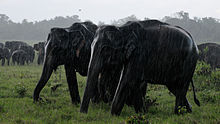 Sri Lankan Elephant is one of three recognized subspecies of the Asian Elephant, and native to Sri Lanka. According to the 2011 elephant census, the country is home to at least 5879 elephants.[149]
Sri Lankan Elephant is one of three recognized subspecies of the Asian Elephant, and native to Sri Lanka. According to the 2011 elephant census, the country is home to at least 5879 elephants.[149]
Lying within the Indomalaya ecozone, Sri Lanka is one of the 25 biodiversity hotspots in the world.[150] Although the country is relatively small in size, it has the highest biodiversity per 10,000 square km in Asia.[151] Remarkably high proportion of the species among its flora and fauna, 27% of the 3,210 flowering plants and 22% of the mammals (see List), are endemic.[152] Sri Lanka has declared 24 wildlife reserves, which are home to a wide range of native species such as Asian elephants, leopards, sloth bears, the unique small loris, a variety of deer, the purple-faced langur, the endangered wild boar, porcupines and anteaters.[153]
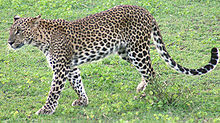 The Sri Lankan Leopard (Panthera pardus kotiya) is an endangered subspecies of leopard native to Sri Lanka.
The Sri Lankan Leopard (Panthera pardus kotiya) is an endangered subspecies of leopard native to Sri Lanka.
Varieties of flowering acacias are well adapted to the arid conditions and flourish on the Jaffna Peninsula. Among the trees of the dry-land forests, are some valuable species such as satinwood, ebony, ironwood, mahogany and teak. In the wet zone, the dominant vegetation of the lowlands is a tropical evergreen forest, with tall trees, broad foliage, and a dense undergrowth of vines and creepers. Subtropical evergreen forests resembling those of temperate climates flourish in the higher altitudes.[154]
The Yala National Park in the southeast protects herds of elephant, deer, and peacocks, and the Wilpattu National Park, the largest national park in Sri Lanka, in the northwest preserves the habitats of many water birds, such as storks, pelicans, ibis, and spoonbills. The island has four biosphere reserves, Bundala, Hurulu Forest Reserve, the Kanneliya-Dediyagala-Nakiyadeniya, and Sinharaja.[155] Out of these, Sinharaja forest reserve is home to 26 endemic birds and 20 rainforest species, including the elusive Red-faced Malkoha, Green-billed Coucal and Sri Lanka Blue Magpie. The untapped genetic potential of Sinharaja flora is enormous. Out of the 211 woody trees and lianas so far identified within the reserve, 139 (66%) are endemic. The Total vegetation density, including trees, shrubs, herbs and seedlings has been estimated to be around 240,000 individuals per hectare.
In addition, Sri Lanka is home to over 250 types of resident birds (see List). It has declared several bird sanctuaries including Kumana.[156] During the Mahaweli Program of the 1970s and 1980s in northern Sri Lanka, the government set aside four areas of land totalling 1,900 km2 (730 sq mi) as national parks. However the country's forest cover, which was around 49% in 1920, had been fallen to approximately 24% by 2009.[157][158]
Politics
Main article: Politics of Sri Lanka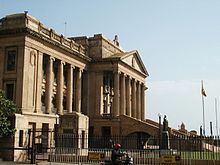 The old parliament building of Sri Lanka, near the Galle Face Green, now the Presidential Secretariat.
The old parliament building of Sri Lanka, near the Galle Face Green, now the Presidential Secretariat.
Sri Lanka is the oldest democracy in South Asia.[159][160] The Donoughmore Constitution, drafted by the Donoughmore Commission in 1931 enabled general elections with adult universal suffrage (universal adult franchise) in the country.[161] It was the first time a non-caucasian country within the empires of Western Europe was given one man, one vote and the power to control domestic affairs. The first election under the universal adult franchise, held in June 1931, for the Ceylon State Council.[159] Sir D. B. Jayatilaka was elected as the Leader of the House.[162] In 1944, the Soulbury Commission was appointed to draft a new constitution. During this time, struggle for Independence was fought on "constitutionalist" lines under the leadership of D. S. Senanayake.[163] The draft constitution was enacted in the same year and Senanayake was appointed as the Prime Minister from the parliamentary election in 1947. The Soulbury constitution ushered in Dominion status and Independence to Sri Lanka in 1948.[161]
Current politics in Sri Lanka is a contest between two rival coalitions led by the centre-leftist and progressivist United People's Freedom Alliance (UPFA), an offspring of Sri Lanka Freedom Party (SLFP), and the comparatively right-wing and pro-capitalist United National Party (UNP).[164] Sri Lanka is essentially a multi-party democracy with many smaller Buddhist, socialist and Tamil nationalist political parties. As of July 2011, the number of registered political parties in the country is 67.[165] Out of these, the Lanka Sama Samaja Party (LSSP), established in 1935 is the oldest.[166] UNP, established by D. S. Senanayake in 1946, was considered to be the largest single political party until recently.[167] It is the only political group which had a representation in all parliaments since the independence.[167] SLFP was founded by S. W. R. D. Bandaranaike, who was the Cabinet minister of Local Administration, before he left the UNP in July 1951.[168] SLFP registered its first victory in 1956, defeating the ruling UNP in 1956 Parliamentary election.[168] Following the parliamentary election in July 1960, Sirimavo Bandaranaike became the prime minister and the world's first elected female head of state.[169]
G. G. Ponnambalam, the Tamil nationalist counterpart of S. W. R. D. Bandaranaike,[170] founded the All Ceylon Tamil Congress (ACTC) in 1944. As an objection to Ponnambalam's cooperation with D. S. Senanayake, a dissident group led by S.J.V. Chelvanayakam broke away in 1949 and formed the Illankai Tamil Arasu Kachchi (ITAK) aka Federal Party. It was the main Tamil political party in Sri Lanka for next 2 decades.[171] Federal party advocated a more aggressive stance vis-à-vis the Sinhalese.[172] With the constitutional reforms of 1972, these parties created a common front, the Tamil United Front (later Tamil United Liberation Front). Tamil National Alliance, formed in October 2001 is the current successor of these Tamil political parties which had undergone much turbulences as Tamil militants' rise to power in late 1970s.[172][173] Janatha Vimukthi Peramuna, a Marxist-Leninist political party, founded by Rohana Wijeweera in 1965, serves as the 3rd force in the current political context.[174] It endorses radical leftist policies, with respect to the traditionalist leftist politics of LSSP and Communist Party.[172] Founded in 1981, Sri Lanka Muslim Congress is the largest Muslim political party in Sri Lanka.[175]
Government
Main articles: Constitution of Sri Lanka and Elections in Sri Lanka National Symbols of Sri Lanka[176][177]
National Symbols of Sri Lanka[176][177]Flag Lion Flag Emblem Gold Lion Passant Anthem Sri Lanka Matha Butterfly Troides darsius Bird Sri Lanka Junglefowl Flower Red and Blue Water Lily Tree Ceylon Ironwood (Naa) Game Volleyball Sri Lanka is a democratic, socialist republic and a unitary state which is governed by a semi-presidential system, with a mixture of a presidential system and a parliamentary system.[178] It constitutes a parliamentary system governed under the Constitution of Sri Lanka. Most provisions of the Constitution of Sri Lanka can be amended by a two-thirds majority in Parliament of Sri Lanka. However, the amendment of certain basic features such as the clauses on language, religion, and reference to Sri Lanka as a unitary state require both a two-thirds majority and approval at a nation-wide referendum.
The Sri Lankan government has 3 branches:
- Executive: The President of Sri Lanka is the head of state, the commander in chief of the armed forces, as well as head of government, and is popularly elected for a six-year term.[179] In the exercise of duties, the President is responsible to the parliament. The President appoints and heads a cabinet of ministers composed of elected members of parliament.[180] President is immune from legal proceedings while in office in respect of any acts done or omitted to be done by him either in his official or private capacity.[181] With the 18th amendment to the constitution in 2010, the President has no term limit, which previously stood at 2.[182]
- Legislative: The Parliament of Sri Lanka, is a unicameral 225-member legislature with 196 members elected in multi-seat constituencies and 29 by proportional representation.[183] Members are elected by universal (adult) suffrage based on a modified proportional representation system by district to a six-year term. The president may summon, suspend, or end a legislative session and dissolve Parliament any time after it has served for one year. The parliament reserves the power to make all laws.[184] President's deputy, the Prime Minister, leads the ruling party in parliament and shares many executive responsibilities, mainly in domestic affairs.
- Judicial: Sri Lanka's judiciary consists of a Supreme Court - the highest and final superior court of record,[184] a Court of Appeal, High Courts and a number of subordinate courts. Its highly complex legal system reflects diverse cultural influences.[185] The Criminal law is almost entirely based on British law. Basic Civil law relates to the Roman law and Dutch law. Laws pertaining to marriage, divorce, and inheritance are communal.[186] Due to ancient customary practices and/or religion, the Sinhala customary law (Kandyan law), the Thesavalamai and the Sharia law too are followed on special cases.[187] The President appoints judges to the Supreme Court, the Court of Appeal, and the High Courts. A judicial service commission, composed of the Chief Justice and two Supreme Court judges, appoints, transfers, and dismisses lower court judges.
Administrative divisions
Main articles: Provinces of Sri Lanka, Districts of Sri Lanka, and Divisional Secretariats of Sri LankaSee also: List of cities in Sri Lanka and List of towns in Sri LankaFor administrative purposes, Sri Lanka is divided into 9 provinces[188] and 25 districts.[189]
- Provinces
Provinces (Sinhala: පළාතTamil: மாகாணம்) have existed in Sri Lanka since the 19th century. But they didn't have any legal status until 1987 when the 13th Amendment to the 1978 Constitution of Sri Lanka established provincial councils following several decades of increasing demand for a decentralisation of the Government of Sri Lanka.[190] The provincial council is an autonomous body and is not under any Ministry. It undertakes activities which had earlier been undertaken by the Central Government Ministries, Departments, Corporations and Statutory Authorities.[190] But importantly, land and police authorities are not given to provincial councils in practice.[191][192] Between 1988 and 2006, the Northern and Eastern provinces were temporarily merged to form the North-East Province.[193][194] Prior to 1987, all administrative tasks were handled by a district-based civil service which had been in place since colonial times. Now each province is administered by a directly elected provincial council:
Administrative Divisions of Sri Lanka Province Capital Area (km²) Area
(sq mi)Population Central Kandy 5,674 2,191 2,423,966 Eastern Trincomalee 9,996 3,859 1,460,939 North Central Anuradhapura 10,714 4,137 1,104,664 Northern Jaffna 8,884 3,430 1,311,776 North Western Kurunegala 7,812 3,016 2,169,892 Sabaragamuwa Ratnapura 4,902 1,893 1,801,331 Southern Galle 5,559 2,146 2,278,271 Uva Badulla 8,488 3,277 1,177,358 Western Colombo 3,709 1,432 5,361,200 - Districts and local authorities
Sri Lanka is also divided into 25 districts (Sinhala: දිස්ත්රික්ක sing. දිස්ත්රික්කයTamil: மாவட்டம்).[195] Each district is administered under a District Secretariat. The districts are further subdivided into 256 divisional secretariats, and these in turn, to approximately 14,008 Grama Niladhari divisions.[196] The Districts are known in Sinhala as Disa and in Tamil as Māwaddam. Originally a Disa (usually rendered into English as Dissavony) was a duchy, notably Matale and Uva. The Government Agent, who is known as District Secretary, administers a district.
There are 3 other types of local authorities: Municipal Councils (18), Urban councils (13) and Pradeshiya Sabha (aka Pradesha Sabhai, 256).[197] Local authorities were originally based on the feudal counties named korale and rata, and were formerly known as 'D.R.O. divisions' after the 'Divisional Revenue Officer'.[198] Later the D.R.O.s became 'Assistant Government Agents' and the divisions were known as 'A.G.A. divisions'. These Divisional Secretariats are currently administered by a 'Divisional Secretary'.
Largest cities of Sri Lanka
(2010 Department of Census and Statistics estimate)[199]Rank City Name Province Pop. Rank City Name Province Pop. 1 Colombo Western 685,246 11 Batticaloa Eastern 97,648 2 Dehiwala-Mount Lavinia Western 234,559 12 Katunayake Western 92,469 3 Moratuwa Western 204,849 13 Battaramulla Western 85,348 4 Negombo Western 144,995 14 Jaffna Northern 84,416 5 Trincomalee Eastern 126,902 15 Dambulla Central 77,148 6 Kotte Western 126,872 16 Maharagama Western 75,127 7 Kandy Central 120,087 17 Dalugama Western 74,428 8 Vavuniya Northern 108,834 18 Kotikawatta Western 72,858 9 Kalmunai Eastern 104,985 19 Anuradhapura North Central 68,244 10 Galle Southern 97,807 20 Kolonnawa Western 64,707 Foreign relations and military
Main articles: Foreign relations of Sri Lanka and Sri Lanka Armed Forces President Mahinda Rajapaksa with Russian President Dmitry Medvedev, at St. Petersburg Economic Forum, in June 2011.
President Mahinda Rajapaksa with Russian President Dmitry Medvedev, at St. Petersburg Economic Forum, in June 2011.
Since its independence in 1948, Sri Lanka has maintained and expanded relationships with most of the countries in the world. Analysis of its foreign relationships helps to recognise two most important traits. One is its commitment in principle to nonalignment, being a a founding member of the Non-Aligned Movement (NAM). Second one is the attempt to preserve satisfactory relations with India without sacrificing its independence.[200] It became a member of the United Nations in 1955. Sri Lanka also is a member of the Commonwealth, the SAARC, World Bank, International Monetary Fund, Asian Development Bank and the Colombo Plan. Sri Lanka continues its active participation in the NAM, while also stressing the importance it places on regionalism by playing a strong role in SAARC.
One of the two parties that have governed Sri Lanka since its independence, UNP, is traditionally biased towards the West, with respect to its left-leaning counterpart, SLFP.[200] Sri Lankan Finance Minister J. R. Jayewardene, together with the then Australian Foreign Minister Sir Percy Spencer, proposed the Colombo Plan at Commonwealth Foreign Minister’s Conference held in Colombo in 1950.[201] In a remarkable move, Sri Lanka spoke in defence for a free Japan, while many coutries were reluctant to allow a free Japan, at the San Francisco Peace Conference in 1951, and refused to accept the payment of reparations for that damage it had done to the country during World War II, that would harm Japan's economy.[202] Sri Lanka-China relations started as soon as the PRC was formed in 1949. Two countries signed an important Rice-Rubber Pact in 1952.[203] Sri Lanka played a vital role in Asian–African Conference in 1955, which was an important step toward the crystallization of the NAM.[204] The Bandaranaike government of 1956 significantly digressed from the pro-western policies of UNP government. Sri Lanka immediately recognised the new Cuba under Fidel Castro in 1959. Shortly after, Cuba's legendary revolutionary Ernesto Che Guevara paid a visit to Sri Lanka.[205] The Sirima-Shastri Pact of 1964[206] and Sirima-Gandhi Pact of 1974[207] were signed between Sri Lankan and Indian leaders in an attempt to solve the long standing dispute over the status of plantation workers of Indian origin. In 1974, Kachchatheevu, a small island in Palk Strait was formally ceded to Sri Lanka.[208] By this time, Sri Lanka was strongly involved in the NAM and Colombo held the fifth NAM summit of 1976.[209] The relationship between Sri Lanka and India became tensed under the government of J. R. Jayawardene.[122][210] As a result, India intervened in Sri Lankan Civil War and subsequently deployed the Indian Peace Keeping Force in 1987.[211] In the present, Sri Lanka enjoys extensive relations with China,[212] Russia[213] and Pakistan.[214]
 Boats belonging to the Sri Lanka Navy
Boats belonging to the Sri Lanka Navy
The Sri Lanka Armed Forces, comprising the Sri Lanka Army, the Sri Lanka Navy and the Sri Lanka Air Force, comes under the purview of the Ministry of Defence (MoD).[215] The total strength of the three services is around 259,000 personnel, with nearly 36,000 reserves.[216] Sri Lanka has not enforced military conscription.[217] In support of the armed forces, there are three paramilitary units functioning: the Special Task Force, the Civil Security Force and the Sri Lanka Coast Guard[218][219]
Since independence from Britain in 1948, the primary focus of the armed forces has been on internal security, due to three major insurgencies, two by Marxist militants of the JVP and a 30 year long conflict with the LTTE which has been proscribed as a terrorist organisation by 32 countries. Due to these conflicts, the armed forces had expanded to its current size and are in a continuous mobilized state for the last 30 years.[220] Marking a rare occurrence in modern military history, Sri Lankan military was able to bring a decisive end to the Sri Lankan Civil War in May 2009.[221] Sri Lanka claimed itself the first country in the modern world to eradicate terrorism on its own soil.[222] Sri Lankan Armed Forces have engaged in United Nations peacekeeping operations since the early 1960s. It has contributed with forces as permanent contingents deployed in several UN peacekeeping missions in Chad, Lebanon and Haiti.[223]
Economy
Main article: Economy of Sri LankaAccording to the International Monetary Fund, Sri Lanka claims to a US$50 billion economy as of 2010.[5] It has a GDP of US$106.5 billion in terms of purchasing power parity. Sri Lanka is next only to Maldives in the South Asian region in terms of per capita income, with a nominal value of US$2,435 and PPP value of US$5,220.[5] It recorded a GDP growth of 8.2% in 2010 and it is estimated that GDP will grow by 9.5% in 2011, becoming one of the fastest growing economies of the world.[5] Colombo Stock Exchange was the best performing stock exchange in Asia in 2009 and 2010, by almost tripling in value during that time.[18]
 The Colombo World Trade Center in Colombo. Presidential Secretariat, Ceylinco House and Cinnamon Lakeside Hotel are also visible in the image.
The Colombo World Trade Center in Colombo. Presidential Secretariat, Ceylinco House and Cinnamon Lakeside Hotel are also visible in the image.
In the 19th and 20th centuries, Sri Lanka became a plantation economy, famous for its production and export of cinnamon, rubber and Ceylon tea, which remains a trademark national export.[224] The development of modern ports under British rule raised the strategic importance of the island as a centre of trade.[225] From 1948 to 1977 socialism strongly influenced the government's economic policies. Colonial plantations were dismantled, industries were nationalised and a welfare state established. In 1977 the Free market economy was introduced to the country, incorporating privatisation, deregulation and the promotion of private enterprise.[115]
While the production and export of tea, rubber, coffee, sugar and other agricultural commodities remains important, the nation has moved steadily towards an industrialised economy with the development of food processing, textiles, telecommunications and finance. Main economic sectors of the country are tourism, tea export, clothing, rice production and other agricultural products. In addition to these economic sectors, overseas employment contributes highly in foreign exchange, most of them from the Middle East.[226] As of 2010, service sector makes up 60% of GDP, industial sector 28% and agriculture sector 12%.[226] Private sector accounts for 85% of the economy.[227] India is the largest trading partner of Sri Lanka.[228] Economic disparies exist between the provinces, with Western province contributing to 45.1% of the GDP, Southern province and Central province, 10.7% and 10% respectively.[229] With the end of the war, Northern province reported a record 22.9% GDP growth in 2010.[230]
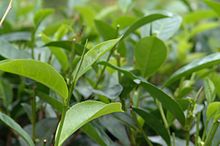 Sri Lanka's most widely known export, Ceylon tea, which is considered the "cleanest" tea in the world. Sri Lanka is also the world's 2nd largest exporter of tea.[231]
Sri Lanka's most widely known export, Ceylon tea, which is considered the "cleanest" tea in the world. Sri Lanka is also the world's 2nd largest exporter of tea.[231]
The per capita income of Sri Lanka has doubled since 2005.[232] During the same period, proverty has dropped from 15.2% to 7.6%, unemployment has dropped from 7.2% to 4.9%, market capitalization of CSE has quadrupled and budget deficit has doubled.[226] 90% of the households in Sri Lanka are electrified, 87.3% of the population have access to safe drinking water and 39% have access to pipe-borne water.[226] Income inequality has also dropped in recent years, indicated by a gini coefficient of 0.36 in 2010.[6] Sri Lanka's cellular subscriber base has shown a staggering 550% growth, from 2005 to 2010.[226] Sri Lanka was the first country in the South Asian region to introduce 3G (Third Generation), 3.5G HSDPA, 3.75G HSUPA and 4G LTE mobile broadband Internet technologies.[233]
The Global Competitiveness Report published by the World Economic Forum has listed Sri Lanka as a transitive economy, from factor-driven stage to efficiency-driven stage, ranking 52nd in the global competitiveness.[234] It also ranked 45th in health and primary education, 32nd in business sophistication, 42nd in innovation and 41st in goods market efficiency out of the 142 countries surveyed. Sri Lanka ranks 8th in the World Giving Index, registering high levels of contentment and charitable behaviour in its society.[235] In 2010, The New York Times placed Sri Lanka at number 1 position in 31 places to visit.[236] Dow Jones classified Sri Lanka as an emerging market in 2010, and Citigroup classified it as a 3G country in February 2011.[237] Sri Lanka ranks well above other South Asian countries in Human Development Index (HDI) with 0.658 points.[238]
Although poverty has reduced by 50% during last 5 years, malnutrition remains a problem among children. 29% of the children under 5 years of age are reported to be underweight.[239] Nearly 58% of infants between 6 and 11 months and 38% of children between 12 and 23 months are anaemic. While Dengue remains the major infectious disease,[240] non-communicable diseasees (NCDs) account for 85% of ill health, disability and early death in Sri Lanka.[241] Sri Lankans have a life expectancy of 77.9 years at birth, which is 10% higher than the world average.[226] Infant mortality rate stands at 8.5 per 1000 births and maternal mortality rate at 0.39 per 1000 births, which is in par with figures of the developed countries. The universal, "pro-poor"[242] health care system adopted by the country has contributed much towards these figures.[243]
Sri Lanka has a A and B class road network exceeding 12,000 kilometres (7,460 mi).[244] It consists of 35 A grade highways connecting major cities. In addition, several expressways are being built.[245] The railway network, operated by the state-run national railway operator, Sri Lanka Railways, spans 1,447 kilometres (900 mi).[246] Sri Lanka also has three deep-water ports, at Colombo, Galle, and Trincomalee, in addition to the newest port being built at Hambantota. Its flag carrier airline is the SriLankan Airlines.
Demographics
Main article: Demographics of Sri LankaSee also: Ethnic groups in Sri Lanka, Languages of Sri Lanka, and Religion in Sri LankaSri Lanka is the 53rd most populated nation in the world, with an annual population growth rate of 0.73%.[247] Sri Lanka has a birth rate of 17.6 births per 1,000 people and a death rate of 6.2 deaths per 1,000 people.[226] Population density is highest in western Sri Lanka, especially in and around the capital. Sinhalese constitue the largest ethnic group in the country, with 74% of the total population.[215] Sri Lankan Tamils are the second major ethnic group in the island, with a percentage of 12.6. Sri Lankan Moors comprise 7.4%. Tamils of Indian origin were brought into the country as indentured labourers by British colonists to work on estate plantations. Nearly 50% of them were repatriated following independence in 1948,[248] They are distinguished from the native Tamil population that has resided in Sri Lanka since ancient times. There are also small ethnic groups such as the Burghers (of mixed European descent) and Austronesian peoples from Southeast Asia. Moreover, there is a small population of Vedda people whom are believed to be the original indigenous group to inhabit the island.[249]
Sinhalese and Tamil are the two official languages of Sri Lanka.[250] Constitution defines English as the link language. English is widely used for education, scientific and commercial purposes. Members of the Burgher community speak variant forms of Portuguese Creole and Dutch with varying proficiency, while members of the Malay community speak a form of Creole Malay that is unique to the island.[251]
Sri Lanka is also a multi-religious country. Buddhism constitutes the religious faith of about 70% of the population of the island,[252] most of whom follow the Theravada school of Buddhism.[253] Buddhism was introduced to Sri Lanka in the 2nd century BCE by Venerable Mahinda.[253] A sapling of the Bodhi Tree under which the Buddha attained enlightenment was brought to Sri Lanka during the same time. The Pali Canon (Thripitakaya), having previously been preserved as an oral tradition, was first committed to writing in Sri Lanka around 30 BCE.[254] Sri Lanka has the longest continuous history of Buddhism of any predominately Buddhist nation,[253] with the Sangha having existed in a largely unbroken lineage since its introduction in the 2nd century BCE. During periods of decline, the Sri Lankan monastic lineage was revived through contact with Thailand and Burma.[254]
 The Nallur Kandaswamy Kovil, Jaffna is one of the most sacred places for Hinduism in Sri Lanka, 10th century AD.
The Nallur Kandaswamy Kovil, Jaffna is one of the most sacred places for Hinduism in Sri Lanka, 10th century AD.
Hinduism is the second most prevalent religion in Sri Lanka which also arrived from India. Hinduism is dominant in Northern, Eastern and Central Sri Lanka. It was primarily established in Sri Lanka by migrants and often invaders from southern India,[255] Islam is the third most dominant religion in the country, having been brought to the island by Arab traders over the course of many centuries, most are Sunni who follow the Shafi'i school.[256]
Christianity was also brought into the country by Western colonists in the early 16th century.[258] Around 8% of the Sri Lankan population are Christians. Out of them, 88% are Roman Catholics, who trace their religious heritage directly to the Portuguese. Rest of the Christians are evenly split between the Anglican Church of Ceylon and other Protestant faiths.[259] There is also a small population of Zoroastrian immigrants from India (Parsis) who settled in Ceylon during the period of British rule.[260] But the community has steadily dwindled in recent years.[261] Religion plays a prominent role in the life and culture of Sri Lankans. The Buddhist majority observe Poya Days, once per month according to the Lunar calendar. The Hindus and Muslims also observe their own holidays. Sri Lanka was ranked the 3rd most religious country in the world by a 2008 Gallup poll, with 99% of Sri Lankans saying religion is an important part of their daily life.[262]
Culture
Main article: Culture of Sri LankaThe culture of Sri Lanka dates back over 2500 years.[263] It is influenced primarily by Buddhism and Hinduism.[264] Accoring to Islamic folklore, Adam and Eve were offered refuge on the island as solace for their expulsion from the Garden of Eden.[265] The island is the home to two main traditional cultures: the Sinhalese (centred in the ancient cities of Kandy and Anuradhapura) and the Tamil (centred in the city of Jaffna). In more recent times, the British colonial culture has also influenced the locals. Sri Lanka claims a democratic tradition matched by few other developing countries.[265]
The first Tamil immigration was probably around the third century BC.[264] Tamils co-existed with the Sinhalese people since then, and the early mixing rendered the two ethnic groups almost physically indistinct.[266] Ancient Sri Lanka is marked for its genius in hydraulic engineering and architecture. The rich cultural traditions is the basis of the country's long life expectancy, advanced health standards and high literacy rate.[265]
Food and festivals
Main articles: Cuisine of Sri Lanka, List of Sri Lankan sweets and desserts, and Festivals in Sri LankaThe customary diet in Sri Lanka are rice and curry, pittu (mixture of fresh rice meal, lightly roasted and mixed with fresh grated coconut, then steamed in a bamboo mould), Kiribath (cooked in thick coconut cream for this unsweetened rice-pudding which is accompanied by a sharp chili relish called "lunumiris"), Roti (made from stoneground wholemeal flour, traditionally known as Atta flour), String hoppers (prepared by mixing rice flour with hot water and salt), wattalapam (rich pudding of Malay origin made of coconut milk, jaggery, cashew nuts, eggs, and various spices including cinnamon cloves and nutmeg), kottu, hoppers ("appa"), etc.[267] Jackfruit may replace rice and curries at times. Traditional meals are usually served on plantain leaf.
Middle Eastern influences and practices are found in traditional Moor dishes. While Dutch and Portuguese influences are found with the island's Burgher community preserving their culture through traditional favourites such as Lamprais (rice cooked in stock and baked in a banana leaf), Breudher (Dutch Christmas cake) and Bolo Fiado (Portuguese-style layer cake).
Every year in mid April, Sri Lankans celebrate the Sinhalese and Hindu new year festival.[268] In addition, Esala Perahera, a symbolic Buddhist festival consisting of dances and richly decorated elephants, is held in Kandy, during the month of August.[269] Fire-dances, whip-dances, Kandian dances and various other cultural dances are integral parts of the festival. Tamils celebrate Thai Pongal, Maha Shivaratri and Muslims celebrate Hajj, Ramadan in their respective days of the year.
Visual, literary and performing arts
Main articles: Cinema of Sri Lanka, Music of Sri Lanka, Dances of Sri Lanka, Theatre of Sri Lanka, and Sri Lankan literatureThe movie Kadawunu Poronduwa (The broken promise), produced by S. M. Nayagam of Chitra Kala Movietone, heralded the coming of Sri Lankan cinema in 1947. Ranmuthu Duwa (Island of treasures, 1962) marked the transition cinema from black-and-white to color. It in the recent years has featured subjects such as family melodrama, social transformation and the years of conflict between the military and the LTTE.[270] Their cinematic style is similar to the Bollywood movies. In 1979, movie attendance rose to an all-time high, but recoded a gradual downfall since then.[271] Undoubtedly the most influential and revolutionary filmmaker in the history of Sri Lankan cinema is Lester James Peiris, who has directed a number of movies which led to global acclaim, including Rekava (Line of destiny, 1956), Gamperaliya (The changing village, 1964), Nidhanaya (The treasure, 1970) and Golu Hadawatha (Cold heart, 1968).[272]
The earliest music in Sri Lanka came from theatrical performances such as Kolam, Sokari and Nadagam.[273] Traditional music instruments such as Béra, Thammátama, Daŭla and Răbān were performed at these dramas. The first music album, Nurthi, was released through Radio Ceylon, in 1903. Songwriters like Mahagama Sekara and Ananda Samarakoon and musicians such as W. D. Amaradeva, H. R. Jothipala and Clarence Wijewardene have contributed much towards the upliftment of Sri Lankan music.[274] Baila is another popular music genre in the country, originated among Kaffirs or the or Afro-Sinhalese community.[275]
There are three main styles of Sri Lankan classical dance. They are, the Kandyan dances, low country dances and Sabaragamuwa dances. Out of these, the Kandyan style, which flourished under kings of the Kingdom of Kandy, is more prominent. It is a sophisticated form of dance,[276] that consists of five sub-categories: Ves dance, Naiyandi dance, Udekki dance, Pantheru dance and 18 Vannam.[277] An elaborate headdress is worn by the male dancers and a drum called Geta Béraya is used to assist the dancer to keep on rhythm.[276] In addion, four folk drama variants named Sokri, Kolam, Nadagam, Pasu, and several devil dance variants such as Sanni Yakuma and Kohomba Kankariya can be also observed.[277]
The history of Sri Lankan painting and sculpture can be traced as far back as to the 2nd or 3rd century BC.[278] The earliest mention about the art of painting on Mahavamsa, is to the drawing of a palace on cloth using cinnabar in the 2nd century BC. The chronicles have description of various paintings in relic-chambers of Buddhist stupas, and in monastic residence. Theatre moved into the country when a Parsi company from Mumbai introduced Nurti, a blend of European and Indian theatrical conventions to the Colombo audience in 19th century.[277] The golden age of Sri Lankan drama and theatre began with the staging of Maname, a play written by Ediriweera Sarachchandra in 1956.[279] It was followed by a series of popular dramas like Sinhabāhu, Pabāvatī, Mahāsāra, Muudu Puththu and Subha saha Yasa.
Theatre moved into the country when a Parsi company from Mumbai introduced Nurti, a blend of European and Indian theatrical conventions to the Colombo audience in 19th century.[277] The golden age of Sri Lankan drama and theatre began with the staging of Maname, a play written by Ediriweera Sarachchandra in 1956.[279] It was followed by a series of popular dramas like Sinhabāhu, Pabāvatī, Mahāsāra, Muudu Puththu and Subha saha Yasa.
The history of Sri Lankan literature runs at least two millennia back, and is heir to the Aryan literary tradition as embodied in the hymns of the Rigveda.[280] The Pāli Canon, the standard collection of scriptures in the Theravada Buddhist tradition, was written down in Sri Lanka during the Fourth Buddhist council, at the Alulena cave temple, Kegalle, as early as 29 BC.[281] Ancient chronicles such as Mahāvamsa, which was written in 6th century provide vivid descriptions of Sri Lankan dynasty. According to the German philosopher Wilhelm Geiger, the chronicles are based on Sinhala Atthakatha (commentary), that dates few more centuries back.[280] The oldest surviving prose work is the Dhampiya-Atuva-Getapadaya, compiled in the ninth century.[280] The greatest literary feats of medieval Sri Lanka include Sandesha Kāvya (poetic messages) such as Girā Sandeshaya (Parrot message), Hansa Sandeshaya (Swan message) and Salalihini Sandeshaya (Myna message). Poetry including Kavsilumina, Kavya-Sekharaya (diadem of poetry) and proses such as Saddharma-Ratnāvaliya, Amāvatura (Flood of nectar) and Pujāvaliya are also notable works of this period, which is considered to be the golden age of Sri Lankan literature.[280] The first modern-day novel, Meena, a work of Simon de Silva appeared in 1905,[277] and was followed by a number of revolutionary literary works. Martin Wickramasinghe, the author of Madol Doova is considered the iconic figure of Sri Lankan literature.[282]
Education
Main article: Education in Sri Lanka Sarachchandra open air theatre of University of Peradeniya,named in memory of Ediriweera Sarachchandra, Sri Lanka's premium playwright.
Sarachchandra open air theatre of University of Peradeniya,named in memory of Ediriweera Sarachchandra, Sri Lanka's premium playwright.
With a literacy rate of 92.5%,[226] Sri Lanka has one of the most literate populations amongst developing nations.[283] Its youth literacy rate stands at 98%,[284] computer literacy rate at 35%,[285] and primary school enrolment rate at over 99%.[286] An education system which dictates 9 years of compulsory schooling for every child is in place. The free education system established in 1945,[287] is a result of the initiative of C. W. W. Kannangara and A. Ratnayake.[285][288] It is one of the few countries in the world that provides universal free education from primary to tertiary stage.[289]
Kannangara led the establishment of the Madhya Maha Vidyalayas (Central Schools) in different parts of the country in order to provide education to Sri Lanka's rural children.[285] In 1942 a special education committee proposed extensive reforms to establish an efficient and quality education system for the people. However in the 1980s changes to this system saw the separation the of administration of schools between the central government and the provincial government. Thus the elite National Schools are controlled directly by the Ministry of Education and the provincial schools by the provincial government. Sri Lanka has approximately 9675 government schools, 817 private schools and Pirivenas.[226] The number of public universities in Sri Lanka is 15.[290] However, lack of responsiveness of the education system to labor market requirements, disparities in access to quality education, lack of an effective linkage between secondary and tertiary education remain major challenges for the education sector.[291] A number of private, degree awarding institutions have emerged in recent times to fill in these gaps. But still, the participation at tertiary level education hovers around 4%.[292]
Human rights and media
Main articles: Human rights in Sri Lanka and Media in Sri LankaSri Lanka Broadcasting Corporation (formerly Radio Ceylon) is the oldest-running radio station in Asia.[293] It was established in 1923 by Edward Harper just three years after broadcasting was launched in Europe.[293] The station broadcasts services in Sinhalese, Tamil, English and Hindi. Since the 1980s, a large number of private radio stations have also being introduced. Broadcast television was introduced to the country in 1979 when the Independent Television Network was launched. Initially all Television stations were state controlled, but private television networks began broadcasts in 1992.[294] As of 2010, 51 newspapers (30 Sinhala, 10 Tamil, 11 English) are published and 34 TV stations and 52 radio stations are operated in the coutry.[226] However in the recent years, freedom of the press in Sri Lanka has been widely criticised by media freedom groups.[295]
Human rights as ratified by the United Nations are guaranteed by the constitution of Sri Lanka. However the human rights in Sri Lanka has also come under criticism by human rights groups such as Amnesty International and Human Rights Watch,[296] as well as the United States Department of State.[297] Both the separatist Liberation Tigers of Tamil Eelam (LTTE) and the government of Sri Lanka are accused of violating human rights. A report by an advisory panel to the UN secretary-general has accused both Sri Lankan government and the LTTE on alleged war crimes committed during final stages of the civil war.[298]
Sports
Main article: Sport in Sri Lanka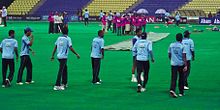 Sri Lankan cricket team practicing ahead of a Twenty20 match against Australia at Pallekele Cricket Stadium, August 2011.
Sri Lankan cricket team practicing ahead of a Twenty20 match against Australia at Pallekele Cricket Stadium, August 2011.
While the national sport in Sri Lanka is volleyball, by far the most popular sport in the country is cricket.[299] Rugby union also enjoys extensive popularity,[300] as do aquatic sports, athletics, football (soccer) and tennis. Sri Lanka's schools and colleges regularly organise sports and athletics teams, competing on provincial and national levels.
The Sri Lanka national cricket team achieved considerable success beginning in the 1990s, rising from underdog status to winning the 1996 Cricket World Cup.[301] They also became the runners up of the Cricket World Cup in 2007,[302] 2011.[303] and of the ICC World Twenty20 in 2009.[304] Former Sri Lankan off-spinner, Muttiah Muralitharan has been rated as the greatest Test match bowler ever by Wisden Cricketers' Almanack.[305] Sri Lanka has won the Asia Cup in 1986,[306] 1997,[307] 2004[308] and 2008.[309] Current world records for highest team score in all three formats of the game are also held by Sri Lanka.[310] The country co-hosted the Cricket World Cup in 1996 and 2011.
Sri Lankans have won two medals at Olympic Games, both silver, by Duncan White at 1948 London Olympics for men's 400 metres hurdles[311] and by Susanthika Jayasinghe at 2000 Sydney Olympics for women's 200 metres.[312] In 1973, Mohammed Lafir won the World Billiards Championship, highest feat of a Sri Lankan in a Cue sport.[313] Aquatic sports such as boating, surfing, swimming, [http://www.kitesurfingsrilanka.com Kitesurfing and scuba diving on the coast, the beaches and backwaters attract a large number of Sri Lankans and foreign tourists. There are two styles of martial arts native to Sri Lanka, Cheena di and Angampora.[314]
See also
References
- ^ "Sri Lanka at a Glance". Sri Lanka Board of Tourism. http://srilanka.travel/index.php?route=information/information&information_id=46. Retrieved 21 August 2011.
- ^ "Sri Lanka: Parliament History". The Official Website of the Government of Sri Lanka. 24 November 2011. http://www.priu.gov.lk/Parliament/ParliamentHistory.html. Retrieved 17 July 2011.
- ^ Department of Economic and Social Affairs Population Division (2009) (PDF). World Population Prospects, Table A.1. 2008 revision. United Nations. http://www.un.org/esa/population/publications/wpp2008/wpp2008_text_tables.pdf. Retrieved 12 March 2009.
- ^ "Estimated mid year population by sex and district - 2010" (PDF). Department of Census and Statistics - Sri Lanka. http://www.statistics.gov.lk/PopHouSat/Mid%20Year%20Population/midyearsex%20&district.pdf. Retrieved 21 August 2011.
- ^ a b c d e f g "Report for Selected Countries and Subjects: Sri Lanka". International Monetary Fund. April 2011. http://www.imf.org/external/pubs/ft/weo/2011/01/weodata/weorept.aspx?sy=2009&ey=2016&scsm=1&ssd=1&sort=country&ds=.&br=1&pr1.x=95&pr1.y=12&c=524&s=NGDP_R%2CNGDP_RPCH%2CNGDP%2CNGDPD%2CNGDP_D%2CNGDPRPC%2CNGDPPC%2CNGDPDPC%2CPPPGDP%2CPPPPC%2CPPPSH%2CPPPEX%2CNID_NGDP%2CNGSD_NGDP%2CPCPI%2CPCPIPCH%2CPCPIE%2CPCPIEPCH%2CTM_RPCH%2CTMG_RPCH%2CTX_RPCH%2CTXG_RPCH%2CTXGO%2CTMGO%2CLUR%2CLP%2CGGR%2CGGR_NGDP%2CGGX%2CGGX_NGDP%2CGGXCNL%2CGGXCNL_NGDP%2CNGDP_FY%2CBCA%2CBCA_NGDPD&grp=0&a=. Retrieved 21 August 2011.
- ^ a b "Inequality drops with poverty" (PDF). Department of Census and Statistics. http://www.statistics.gov.lk/poverty/PovertyIndicators2009_10.pdf. Retrieved 2 September 2011.
- ^ "Human Development Report 2011. Human development index trends: Table 1" (PDF). United Nations Development Programme. http://hdr.undp.org/en/media/HDR_2011_EN_Complete.pdf. Retrieved 5 November 2011.
- ^ ""Sri Lanka" in several reference works". Dictionary.com. http://dictionary.reference.com/browse/Sri+Lanka?r=66. Retrieved 2010-06-02.
- ^ "Carnegie Mellon University Pronouncing Dictionary". Carnegie Mellon University. http://www.speech.cs.cmu.edu/cgi-bin/cmudict?stress=-s&in=SRI-LANKA. Retrieved 2010-06-02.
- ^ British Prime Minister Winston Churchill described the moment a Japanese fleet prepared to invade Sri Lanka as "the most dangerous and distressing moment of the entire conflict". – Commonwealth Air Training Program Museum, The Saviour of Ceylon
- ^ Bandaranayake, Senake; Yuneskō Jātika Maṇḍalaya, Sri Lanka; Lanka), Madhyama Saṃskr̥Tika Aramudala (Sri (1990). "Sri Lankan Role in the Martime Silk Route, pp. 21". Sri Lanka and the silk road of the sea. ISBN 9789559043027. http://books.google.com/books/about/Sri_Lanka_and_the_silk_road_of_the_sea.html?id=xmNuAAAAMAAJ. Retrieved 21 August 2011.
- ^ "Religions – Buddhism: Theravada Buddhism". BBC. 2002-10-02. http://www.bbc.co.uk/religion/religions/buddhism/subdivisions/theravada_1.shtml. Retrieved 2010-06-02.
- ^ "Encyclopædia Britannica: Vedda". Encyclopædia Britannica. http://www.britannica.com/EBchecked/topic/624466/Vedda. Retrieved 21 August 2011.
- ^ "Cinnamon". Encyclopædia Britannica: Cinnamon. Encyclopædia Britannica. 2008. "(species Cinnamomum zeylanicum), bushy evergreen tree of the laurel family (Lauraceae) native to Bangladesh, Sri Lanka (Ceylon), the neighboring Malabar Coast of India, and Myanmar (Burma), and also cultivated in South America and the West Indies for the spice consisting of its dried inner bark. The bark is widely used as a spice due to its distinct odor."
- ^ "Sri Lanka's Way Forward: The Imperative to Foster Civic Engagement, Dialogue, and Reconciliation among Youth". Center for International Private Enterprise. http://www.cipe.org/featureservice/?p=23. Retrieved 21 August 2011.
- ^ Roberts, Brian (2006). "Sri Lanka: Introduction". Urbanization and sustainability in Asia: case studies of good practice. ISBN 9789715616072. http://books.google.com/?id=PD8DseEWyuoC&printsec=frontcover#v=onepage&q&f=false. Retrieved 21 August 2011.
- ^ Domrös, Manfred (1998). Sri Lanka, past and present: Archaeology, Geography, Economics: selected papers on German research. ISBN 9783823612896. http://books.google.com/books?id=xhduAAAAMAAJ. Retrieved 21 August 2011.
- ^ a b "Sri Lanka shares up on retail buying; rupee down". Reuters. 18 August 2011. http://www.reuters.com/article/2011/08/18/markets-srilanka-idUSL3E7JI2T620110818. Retrieved 18 August 2011.
- ^ Abeydeera, Ananda. "In Search of Taprobane: the Western discovery and mapping of Ceylon". http://www.rootsweb.com/~lkawgw/slm-taprobane.htm. Retrieved 2007-06-04.
- ^ "Sri Lanka — The Pearl of the Orient". Metropolis. Archived from the original on October 27, 2002. http://web.archive.org/web/20021027171913/http://www.metropolis.co.jp/tokyotravel/tokyoworldtravelarchive299/295/tokyoworldtravelinc.htm. Retrieved 2007-06-04.
- ^ Rajasingham, K. T.. "Sri Lanka: The untold story". Asia Times. http://www.atimes.com/ind-pak/CH11Df02.html. Retrieved 2007-06-04.
- ^ Zubair, Lareef. "Etymologies of Lanka, Serendib, Taprobane and Ceylon". Archived from the original on April 22, 2007. http://web.archive.org/web/20070422115208/http://www.glue.umd.edu/~pkd/sl/facts/name_origin.html. Retrieved 2007-06-04.
- ^ de Silva, Colin (14 February 1982). "Sri Lanka, The 'Resplendent Isle'". The New York Times. http://query.nytimes.com/gst/fullpage.html?sec=travel&res=9A01EED61E38F937A25751C0A964948260. Retrieved 2007-06-04.
- ^ "Chapter I — The People, The State And Sovereignty". THe Constitution of the Democratic Socialist Republic of Sri Lanka. http://www.priu.gov.lk/Cons/1978Constitution/Chapter_01_Amd.html. Retrieved 2007-06-04.
- ^ Haviland, Charles (2011-01-01). "Sri Lanka erases colonial name, Ceylon". BBC. http://www.bbc.co.uk/news/world-south-asia-12099596. Retrieved 2011-07-17.
- ^ Deraniyagala, Siran U.. "Pre and Protohistoric settlement in Sri Lanka". XIII U. I. S. P. P. Congress Proceedings- Forli, 8 – 14 September 1996. International Union of Prehistoric and Protohistoric Sciences. http://www.lankalibrary.com/geo/dera1.html. Retrieved 09-08-2008.
- ^ "Pahiyangala (Fa-Hiengala) Caves". angelfire.com. http://www.angelfire.com/in4/visitsl/prehistoric/pahiyagala/pahiyangala.htm.
- ^ Kennedy, Kenneth A. R., Disotell, T. W., Roertgen, J., Chiment, J., Sherry, J.. Ancient Ceylon 6: Biological anthropology of upper Pleistocene hominids from Sri Lanka: Batadomba Lena and Beli Lena caves. pp. 165–265.
- ^ De Silva 1981, pp. 6–7
- ^ Deraniyagal, Siran (1992). The Prehistory of Sri Lanka. Colombo: Department of Archaeological Survey. p. 454. ISBN 978-9559-159-00-1.
- ^ Keshavadas, Sant (1988). Ramayana at a Glance. Motilal Banarsidass. ISBN 8120805453.
- ^ Parker, H. (1992). Ancient Ceylon. Asian Educational Services. p. 7. ISBN 978-8120-602-08-3.
- ^ "Ravana - historical or mythical figure?". Padma Edirisinghe. The Sunday Observer. 2009. http://www.sundayobserver.lk/2009/11/15/spe06.asp.
- ^ "Was Maya Dannawa The Architect of Sigiriya?". ramayanaresearch.com. http://www.ramayanaresearch.com/articles/maya_dannawa.html.
- ^ "Early Man and the Rise of Civilisation in Sri Lanka: the Archaeological Evidence". Deraniyagala, S. U.. lankalibrary.com. http://www.lankalibrary.com/geo/dera2.html.
- ^ Sir Henry Yule, A. C. Burnell, William Crooke (2006). A glossary of colloquial Anglo-Indian words and phrases. Asian Educational Services. p. 344. ISBN 978-0700-703-21-0.
- ^ "The Great Chronicle of Sri Lanka". The Mahavamsa. http://mahavamsa.org/. Retrieved 2011-11-04.
- ^ "Vijaya and the Lankan Monarchs - Family #3000". Ancestry.com. http://www.rootsweb.ancestry.com/~lkawgw/gen3000.html.
- ^ "World Heritage site: Anuradhapura". worldheritagesite.org. http://www.worldheritagesite.org/sites/anuradhapura.html.
- ^ "King Pandukabhaya (437 BC – 367 BC)". Mahavamsa. http://mahavamsa.org/2008/05/king-pandukabhaya-437-bc-367-bc/.
- ^ "Waterworld: Ancient Sinhalese Irrigation". mysrilankaholidays.com. http://mysrilankaholidays.com/ancient-sinhalese-irrigation.html.
- ^ "Buddhism in Sri Lanka: A Short History". Perera H. R.. accesstoinsight.org. http://www.accesstoinsight.org/lib/authors/perera/wheel100.html#preface.
- ^ Holt, John Clifford (2004). "Sri Lanka". In Buswell, Jr., Robert E.. Macmillan Encyclopedia of Buddhism. USA: Macmillan Reference USA. pp. 795–799. ISBN 978-0816-054-59-6.
- ^ a b "King Devanampiya Tissa (306 BC – 266 BC)". Mahavamsa. http://mahavamsa.org/2008/05/king-devanampiya-tissa-306-bc/.
- ^ "Buddhism in Sri Lanka". buddhanet.net. http://www.buddhanet.net/e-learning/buddhistworld/lanka-txt.htm.
- ^ a b "Theri Sanghamitta and the Bodhi Tree" (PDF). Paw, Maung. usamyanmar.net. http://www.usamyanmar.net/Buddha/Article/The%20Theri%20Arahant%20Sanghamitta.pdf.
- ^ "Historical trees: Overlooked aspect of heritage that needs a revival of interest". Gunawardana, Jagath. Daily Mirror. http://print.dailymirror.lk/features/139-feature/38344.html.
- ^ "Ruvanveli Seya - The Wonderous Stupa Built by Gods and Men" (PDF). beyondthenet.net. http://www.beyondthenet.net/Saddha/ruvan.pdf.
- ^ "Distortion of history for political purposes". De Silva, Harris. Ancestry.com. http://www.rootsweb.ancestry.com/~lkawgw/usurpation.html.
- ^ a b Sarachchandra, B. S. (1977) (in Sinhala). අපේ සංස්කෘතික උරුමය [Our Cultural Heritage]. Silva, V. P.. pp. 121–122.
- ^ "The History Of Ceylon". sltda.gov.lk. http://www.sltda.gov.lk/history. Retrieved 8 September 2011.
- ^ "Ancient City of Sigiriya". UNESCO. http://whc.unesco.org/en/list/202. Retrieved 2008-01-18.
- ^ "Exploring Sigiriya Rock". AsiaExplorers.com. http://www.asiaexplorers.com/srilanka/sigiriya.htm. Retrieved 2008-05-05.
- ^ "The water regulation technology of ancient Sri Lankan reservoirs: The Bisokotuwa sluice" (PDF). slageconr.net. http://www.slageconr.net/slsnet/9thicsls/individual/abs164.pdf. Retrieved 20 August 2011.
- ^ "Hospitals in ancient Sri Lanka". lankalibrary.com. http://www.lankalibrary.com/geo/hospitals.htm. Retrieved 8 September 2011.
- ^ "International relations in ancient and medieval Sri Lanka". Flickr. http://www.flickr.com/photos/menik/2208629145/. Retrieved 20 August 2011.
- ^ a b Siriweera (2004), p. 44
- ^ Siriweera (2004), p. 45
- ^ Codrington, H.W (1926). A Short History of Ceylon. London: Macmillan & Co.. ISBN 978-0836-955-96-5. OCLC 2154168. http://lakdiva.org/codrington/chap04.html.
- ^ "A Brief History of Sri Lanka". Tim Lambert. localhistories.org. http://www.localhistories.org/srilanka.html. Retrieved 2008-09-12.
- ^ Bokay, Mon (1966). Relations between Ceylon and Burma in the 11th Century AD. Artibus Asiae Publishers. p. 93. http://www.jstor.org/pss/1522637.
- ^ "Ancient Irrigation Works". lakdiva.org. http://lakdiva.org/coins/medievallanka/1153_1186_parakramabahu~i_Em.html. Retrieved 20 August 2011.
- ^ R. B. Herath (2002). Sri Lankan Ethnic Crisis: Towards a Resolution. Trafford Publishing. p. 19. ISBN 978-1553-697-93-0. "Parakramabahu 1 further extended the system to the highest resplendent era of hydraulic civilization of the country's history."
- ^ Journal of the Royal Asiatic Society of Great Britain and Ireland: Volume 7. Cambridge: Cambridge University Press for the Royal Asiatic Society. 1875. p. 152. http://books.google.com/books?id=rPo78i8KrlEC&q. "...and when at the height of its prosperity, during the long and glorious reign of Parakramabahu the Great..."
- ^ The Annals and magazine of natural history: zoology, botany, and geology, Volume 1. New Jersey: Princeton University. 1894. p. 324. http://books.google.com/?id=VRngAAAAMAAJ&dq. "His [Parakramabahu's] reign is described by Tumour as having been the most martial, enterprising, and glorious in Singhalese history."
- ^ a b R. B. Herath (2002). Sri Lankan Ethnic Crisis: Towards a Resolution. Trafford Publishing. pp. 18–21. ISBN 978-1553-697-93-0.
- ^ "Parakrama Samudra". International Lake Environment Committee. http://www.ilec.or.jp/database/asi/asi-45.html. Retrieved 2011-11-04.
- ^ "ParakramaBahu I : 1153 - 1186". lakdiva.org. http://srilankanheritage.com/index.php?option=com_content&view=article&id=28&Itemid=32&lang=en. Retrieved 20 August 2011.
- ^ Jayasekera, P. V. J. (1992). Security dilemma of a small state, Part 1. Peradeniya: Institute for International Studies University of Peradeniya, Sri Lanka. p. 25. ISBN 978-8170-031-48-2. http://books.google.com/?id=VRngAAAAMAAJ&dq. "..His invasion in 1215 was more or less a looting expedition.."
- ^ Nadarajan , V History of Ceylon Tamils, p.72
- ^ Indrapala, K Early Tamil Settlements in Ceylon, p.16
- ^ Gnanaprakasar, Swamy (2003). A Critical History of Jaffna. New Delhi: Asian Educational Services. p. 122. ISBN 81-206-1686-3.
- ^ Holt, John Clifford (1991). Buddha in the Crown: Avalokitesvara in the Buddhist Traditions of Sri Lanka. Oxford University Press. p. 304. ISBN 01-950-6418-6.
- ^ "The Kotte Dynasty and its Portuguese allies". Coddrington, Humphry. http://lakdiva.org/codrington/chap06.html. Retrieved 2008-01-03.
- ^ "Sri Lanka History". Thondaman Foundation. http://www.thondaman.org/srilankanhistory.html. Retrieved 22 August 2011.
- ^ "King Wimaladharmasuriya". S. B. Karalliyadde - The Island. http://www.island.lk/2005/08/27/satmag1.html. Retrieved 22 August 2011.
- ^ Knox, Robert (1681). An Historical Relation of the Island Ceylon. London: Reprint. Asian Educational Services. pp. 19–47.
- ^ Anthonisz, Richard Gerald (2003). The Dutch in Ceylon: an account of their early visits to the island, their conquests, and their rule over the maritime regions during a century and a half. Asian Educational Services. pp. 37–43. ISBN 978-8120-618-45-9. http://books.google.lk/books?id=h2mkUharg6AC.
- ^ Bosma, U. (2008). Being "Dutch" in the Indies: a history of creolisation and empire, 1500-1920. University of Michigan. pp. Chapter 1. ISBN 978-0896-802-61-2. http://books.google.nl/books?id=47wCTCJX9X4C.
- ^ a b c "A kingdom is born, a kingdom is lost". The Sunday Times. http://sundaytimes.lk/070304/KandyTimes/514_kt1.html. Retrieved 22 August 2011.
- ^ Dharmadasa, K. N. O. (1992). Language, Religion, and Ethnic Assertiveness: The Growth of Sinhalese Nationalism in Sri Lanka0. University of Michigan Press. pp. 8–12. ISBN 978-0472-102-88-4.
- ^ Codrington, chap.9
- ^ "The first English occupation and the definitive Dutch surrender". colonialvoyage.com. http://www.colonialvoyage.com/eng/asia/sri_lanka/trincomalee/history_8.html. Retrieved 22 August 2011.
- ^ a b "History of Sri Lanka and significant World events from 1796 AD to 1948". scenicsrilanka.com. http://www.scenicsrilanka.com/history-of-sri-lanka-1948.html. Retrieved 22 August 2011.
- ^ Codrington, A Short History, chap.11
- ^ "Keppetipola and the Uva Rebellion". lankalibrary.com. http://www.lankalibrary.com/geo/keppetipola2.htm. Retrieved 22 August 2011.
- ^ a b Corea & Kelegama 2004, pp. 405–406
- ^ Nubin 2002, p. 115
- ^ "Gongale Goda Banda (1809-1849) : The leader of the 1848 rebellion". Wimalaratne, K. D. G.. http://www.lankalibrary.com/geo/gongalegoda.htm. Retrieved 22 August 2011.
- ^ Nubin 2002, pp. 116–117
- ^ Bond, George D. (1992). The Buddhist revival in Sri Lanka: Religious tradition, reinterpretation and response. Motilal Banarsidass Publications. pp. 11–22. ISBN 978-8120-810-47-1. http://books.google.lk/books?id=Q11ID2xfqD8C&dq.
- ^ "Cutting edge of Hindu revivalism in Jaffna". Balachandran, P. K.. 25 June 2006. http://www.tamilweek.com/Cutting_edge_hindu_revivalism_0625.html. Retrieved 17 September 2011.
- ^ De Silva 1981, p. 387
- ^ De Silva 1981, p. 386
- ^ De Silva 1981, pp. 389–395
- ^ a b "Chronology of events related to Tamils in Sri Lanka (1500 -1948)". Hellmann-Rajanayagam, Dagmar. National University of Malaysia. http://tamilelibrary.org/teli/slhist.html. Retrieved 18 September 2011.
- ^ De Silva 1981, p. 423
- ^ "Sinhalese Parties". Library of Congress Country Studies. http://countrystudies.us/sri-lanka/21.htm. Retrieved 18 September 2011.
- ^ "Sinhalese Parties". Library of Congress Country Studies. http://countrystudies.us/sri-lanka/68.htm. Retrieved 20 August 2011.
- ^ Nubin 2002, pp. 121–122
- ^ "Bandaranaike and Hartal of 1953". Weerakoon, Batty. The Island. http://www.island.lk/2008/08/16/satmag1.html. Retrieved 18 September 2011.
- ^ Nubin 2002, pp. 123
- ^ Ganguly, Šumit(Author); Michael, E. Brown(Editor) (2003). Fighting Words: language policy and ethnic relations in Asia. The MIT Press. pp. 136–138. ISBN 978-0262-523-33-2. http://books.google.com/?id=fcoDezu1ABoC.
- ^ Schmidt, Bettina(Editor); Schroeder, Ingo(Editor) (2001). Anthropology of Violence and Conflict. Routledge. p. 185. ISBN 9780415229050. http://books.google.com/?id=Rx-1MdUlzaUC.
- ^ Peebles, Patrick (2006-08-30). The History of Sri Lanka. Greenwood Press. pp. 109–111. ISBN 978-0313-332-05-0. http://books.google.lk/books?id=SxO0eISluqEC.
- ^ University of Edinburgh. "Staff profile : Jonathan Spencer". http://www.sps.ed.ac.uk/staff/social_anthropology/spencer_jonathan. Retrieved 20 August 2011.
- ^ "Sri Lanka: The untold story - Assassination of Bandaranaike". Rajasingham, K. T.. Asia Times. 2002. http://www.atimes.com/ind-pak/Cl01Df05.html. Retrieved 2011-02-05.
- ^ Nubin 2002, pp. 128–129
- ^ De Silva, K. M. (July 1997). "Affirmative Action Policies: The Sri Lankan Experience" (PDF). International Center for Ethnic Studies. http://www.ices.lk/publications/esr/articles_jul97/Esr-kmdesilva.PDF. Retrieved 18 september 2011.
- ^ Jayasuriya, J. E. (1981). Education in the Third World. Pune: Indian Institute of Education. OCLC 7925123.
- ^ Taraki Sivaram (May 1994). "The Exclusive Right to Write Eelam History". Tamil Nation. http://tamilnation.co/forum/sivaram/940508eelam_history.htm. Retrieved 2011-07-27.
- ^ Hoffman, Bruce (2006). Inside Terrorism. New York: Columbia University Press. p. 139. ISBN 9780-231-12699-1.
- ^ Rohan Gunaratna (December 1998). "International and Regional Implications of the Sri Lankan Tamil Insurgency". http://212.150.54.123/articles/articledet.cfm?articleid=57. Retrieved 2011-07-27.
- ^ Rajasingham, K. T. (2002). "Tamil militancy - a manifestation". http://www.atimes.com/ind-pak/DA26Df04.html. Retrieved 18 September 2011.
- ^ a b "Sri Lanka – an Overview". Fulbright commission. http://www.fulbrightsrilanka.com/?page_id=561. Retrieved 2011-07-25.
- ^ "The Black July 1983 that Created a Collective Trauma". Jayatunge, Ruwan M.. LankaWeb. 2010. http://www.lankaweb.com/news/items/2010/04/27/the-black-july-1983-that-created-a-collective-trauma/. Retrieved 25 September 2011.
- ^ "LTTE: the Indian connection". Sunday Times. 1997. http://sundaytimes.lk/970119/plus4.html. Retrieved 2011-07-25.
- ^ "Uppermost in our minds was to save the Gandhis' name". Express India. 1997. http://www.expressindia.com/ie/daily/19971212/34650923.html. Retrieved 2011-07-25.
- ^ "For firmer and finer International Relations". Wijesinghe, Sarath. Sri Lanka Guardian. http://www.srilankaguardian.org/2009/07/for-firmer-and-finer-international.html. Retrieved 18 september 2011.
- ^ Stokke, K.; Ryntveit, A.K. (2000). "The Struggle for Tamil Eelam in Sri Lanka". A Journal of Urban and Regional Policy 31 (2): 285–304. doi:10.1111/0017-4815.00129.
- ^ Gunaratna, Rohan (1998). Sri Lanka's Ethnic Crisis and National Security. Colombo: South Asian Network on Conflict Research. p. 353. ISBN 955-8093-00-9.
- ^ a b "Chapter 30: Whirlpool of violence, Sri Lanka: The Untold Story". Asia Times. 2002. http://www.atimes.com/ind-pak/DC09Df04.html. Retrieved 2011-07-25.
- ^ "WSWS.org". WSWS.org. 2005-12-29. http://www.wsws.org/articles/2005/dec2005/sri2-d29.shtml. Retrieved 2010-08-12.
- ^ "Sri Lankan TV broadcasts 'video of body of Tamil Tiger leader' as President declares the country liberated from terrorism". Daily Mail. 20 May 2009. http://www.dailymail.co.uk/news/article-1183961/Sri-Lankan-TV-broadcasts-video-body-Tamil-Tiger-leader-President-declares-country-liberated-terrorism.html. Retrieved 18 August 2011.
- ^ "Sri Lanka declares end to war with Tamil Tigers". London: The Guardian. 19 May 2009. http://www.guardian.co.uk/world/2009/may/18/tamil-tigers-killed-sri-lanka. Retrieved 18 August 2011.
- ^ "Up to 100,000 killed in Sri Lanka's civil war: UN". ABC Australia. 20 May 2009. http://www.abc.net.au/news/stories/2009/05/20/2576543.htm.
- ^ "Sri Lanka Tamil party drops statehood demand". BBC. 13 March 2010. http://news.bbc.co.uk/2/hi/south_asia/8566114.stm. Retrieved 18 August 2011.
- ^ "Sri Lankan Tamils drop demand for separate independent homeland". The Guardian. 14 March 2010. http://www.guardian.co.uk/world/2010/mar/14/tamils-drop-calls-for-separate-state. Retrieved 18 August 2011.
- ^ "Sri Lanka ready for the challenge". The Sunday Observer. 20 March 2011. http://www.sundayobserver.lk/2011/03/20/fea01.asp. Retrieved 22 August 2011.
- ^ "Sri Lanka's displaced face uncertain future as government begins to unlock the camps". Amnesty International. 2009-09-11. http://www.amnesty.org/en/news-and-updates/news/sri-lanka-displaced-uncertain-future-government-unlock-camps-20090911. Retrieved 2011-07-17.
- ^ "Situation Report as at 19-08-2011" (PDF). Ministry of Resettlement in Sri Lanka. 19 August 2011. http://www.resettlementmin.gov.lk/download/SituationReport%2019-08-2011.pdf. Retrieved 22 August 2011.
- ^ "Lanka among fastest growing millionaire populations - report". 24 June 2011. http://www.sundayobserver.lk/2011/07/03/oostory.asp?sid=20110624_01&imid=SO.jpg&dt=%5BJune%2024%202011%5D. Retrieved 24 June 2011.
- ^ Ali, Jason R.; Aitchison, Jonathan C. (2005). "Greater India". Earth-Science Reviews 72 (3–4): 170–173. doi:10.1016/j.earscirev.2005.07.005.
- ^ "Geographic Coordinates for Sri Lanka Towns and Villages". jyotisha.00it.com. http://jyotisha.00it.com/Lankaco.htm. Retrieved 22 August 2011.
- ^ "Gods row minister offers to quit". BBC. 2007-09-15. http://news.bbc.co.uk/2/hi/south_asia/6996621.st. Retrieved 2011-07-17.
- ^ Garg, Ganga Ram (1992). "Adam's Bridge". Encyclopaedia of the Hindu World. A-Aj. New Delhi: South Asia Books. p. 142. ISBN 978-8126-134-89-2.
- ^ "Ramar Sethu, a world heritage centre?". Rediff.com. http://www.rediff.com/news/2007/jul/04spec.htm. Retrieved 2011-07-17.
- ^ "Climate & Seasons: Sri Lanka". mysrilanka.com. http://www.mysrilanka.com/travel/theland/climate.htm. Retrieved 22 August 2011.
- ^ "Sri Lanka Rainfall". mysrilanka.com. http://www.mysrilanka.com/travel/theland/rainfall.htm. Retrieved 22 August 2011.
- ^ "Sri Lanka Climate Guide". climatetemp.info. http://www.climatetemp.info/sri-lanka/. Retrieved 22 August 2011.
- ^ Aves, Edward (2003). Sri Lanka. London: Footprint Travel Guides. p. 372. ISBN 978-1903-471-78-4.
- ^ "Introducing Sri Lanka". Lonely Planet. http://www.lonelyplanet.com/sri-lanka. Retrieved 9 September 2011.
- ^ a b "Depletion of coastal resources" (PDF). United Nations Environment Programme. http://www.rrcap.unep.org/pub/soe/srilanka_coastal.pdf.
- ^ "5 Coral Reefs of Sri Lanka: Current Status And Resource Management". Food and Agriculture Organization. http://www.fao.org/docrep/X5627E/x5627e09.htm. Retrieved 12 September 2011.
- ^ "Information Brief on Mangroves in Sri Lanka". International Union for Conservation of Nature. http://www.elanguages.org/files/144094. Retrieved 12 September 2011.
- ^ "Sri Lanka Graphite Production by Year". indexmundi.com. 2009. http://www.indexmundi.com/minerals/?country=lk&product=graphite&graph=production.
- ^ "Availability of sizeable deposits of thorium in Sri Lanka". Tissa Vitharana. Asian Tribune. 2008. http://www.asiantribune.com/node/13747.
- ^ "Three Dimensional Seismic Survey for Oil Exploration in Block SL-2007-01-001 in Gulf of Mannar-Sri Lanka" (PDF). Cairn Lanka. 2009. http://www.prds-srilanka.com/pdfs/Sri_Lanka_Seismic_EIA_Final_Report.pdf. Retrieved 12 September 2011.
- ^ "Sri Lanka Survey Finds More Elephants Than Expected". Voice of America. 2 September 2011. http://www.voanews.com/english/news/asia/Sri-Lanka-Survey-Finds-More-Elephants-Than-Expected-129086673.html. Retrieved 12 September 2011.
- ^ Russell Mittermeier, Norman Myers and Cristina Mittermeier (2000). Hotspots: Earth's Biologically Richest and Most Endangered Terrestrial Ecoregions. Arlington, Virginia: Conservation International. ISBN 978-9686-397-58-1.
- ^ "Environment Sri Lanka". www.environmentlanka.com. http://www.environmentlanka.com/. Retrieved 22 August 2011.
- ^ "An interview with Dr. Ranil Senanayake, chairman of Rainforest Rescue International". news.mongabay.com. http://news.mongabay.com/2006/1106-interview_ranil.html. Retrieved 23 August 2011.
- ^ "Ecotourism Sri Lanka". www.environmentlanka.com. http://www.environmentlanka.com/ecotour.php. Retrieved 22 August 2011.
- ^ "Forests, Grasslands, and Drylands-- Sri Lanka" (PDF). http://earthtrends.wri.org/pdf_library/country_profiles/for_cou_144.PDF. Retrieved 2011-07-17.
- ^ "Sri Lanka". UNESCO. 01-09-2006. http://www.unesco.org/mabdb/br/brdir/directory/contact.asp?code=SRL. Retrieved 2009-05-21.
- ^ "Kumana National Wildlife Park". www.srilankaecotourism.com. http://www.srilankaecotourism.com/kumana_national_park.htm. Retrieved 22 August 2011.
- ^ "Forests of Sri Lanka". srilankanwaterfalls.net. http://www.srilankanwaterfalls.net/about/forests.htm. Retrieved 23 August 2011.
- ^ "Sri Lanka". Sri Lanka. MSN Encarta Encyclopedia. http://encarta.msn.com/encyclopedia_761568352_2/sri_lanka.html. Retrieved April 22, 2009.
- ^ a b Syed, M.H. (2003). Encyclopaedia of Saarc Nations, Volume 3. India: Gyan Publishing House. ISBN 978-8178-351-25-4. http://books.google.com/books?id=O4aAzbmPKIcC&dq. "It is anyway known for having the oldest democracy in South Asia, having an electoral system with universal franchise since 1931."
- ^ Norton, James H.K. (2001). India and South Asia. United States: McGraw-Hill. ISBN 978-0072-432-98-5.
- ^ a b Russell, Jane (1982). Communal Politics Under the Donoughmore Constitution. Colombo: Tisara Publishers.
- ^ "The Constitution of Sri Lanka – Contents". Parliament of Sri Lanka. http://www.parliament.lk/handbook_of_parliament/leaders_of_house.jsp. Retrieved 23 August 2011.
- ^ Kanapathipillai, Valli (2009). Citizenship and Statelessness in Sri Lanka: The Case of the Tamil Estate Workers. India: Anthem Press. p. 187. ISBN 9781843317913. http://books.google.com/books?id=QI7HNNa48WMC&dq. "DS Senanayake, as the leader of the UNP and the first prime minister of Sri Lanka, wore the robes of a "constitutionalist" who peacefully pressured the British for constitutional rights"
- ^ Nubin 2002, p. 95
- ^ "Political Parties in Sri Lanka". Department of Election, Sri Lanka. July 2011. http://www.slelections.gov.lk/pp.html. Retrieved 2011-07-17.
- ^ "Sri Lanka's oldest political party". Daily News. 18 December 2010. http://www.dailynews.lk/2010/12/18/fea01.asp. Retrieved 23 August 2011.
- ^ a b "UNP: The Story of the Major Tradition". unplanka.com. http://www.unplanka.com/. Retrieved 23 August 2011.
- ^ a b "Charting a new course for Sri Lanka's success". Daily News. 16 November 2009. http://www.dailynews.lk/2009/11/16/fea03.asp. Retrieved 23 August 2011.
- ^ "Ceylon chooses world's first woman PM". BBC. 20 July 2960. http://news.bbc.co.uk/onthisday/hi/dates/stories/july/20/newsid_2784000/2784527.stm. Retrieved 25 August 2011.
- ^ Society of Jesus in India (1946). New review, Volume 23. India: Macmillan and co. ltd.. p. 78. http://books.google.com/books?id=m4Y9AAAAYAAJ&q.
- ^ Lakshman, W. D. and Tisdell, Clem (2000). Sri Lanka's development since independence: socio-economic perspectives and analyses. New York: Nova Publishers. p. 80. ISBN 978-1560-727-84-2. http://books.google.com/books?id=MLqmdDp3l0oC&dq.
- ^ a b c "Sri Lanka: Post Colonial History". Lanka Library. http://www.lankalibrary.com/geo/postcolonial_history.htm. Retrieved 25 August 2011.
- ^ "Sri Lanka Tamil National Alliance denies having talks with Buddhist prelates". Asian Tribune. 24 February 2011. http://www.asiantribune.com/news/2011/02/24/sri-lanka-tamil-national-alliance-denies-having-talks-buddhist-prelates. Retrieved 23 August 2011.
- ^ "Revolutionary Idealism and Parliamentary Politics" (PDF). Asia-Pacific Journal of Social Sciences. December 2010. http://socialsciences-ejournal.org/SP%2012.%20Shathasiri.pdf. Retrieved 23 August 2011.
- ^ "Sri Lankan Muslims: Between ethno-nationalism and the global ummah" (PDF). Dennis B. McGilvray. Association for the Study of Ethnicity and Nationalism. January 2011. http://onlinelibrary.wiley.com/doi/10.1111/j.1469-8129.2010.00460.x/pdf. Retrieved 15 September 2011.
- ^ "National Symbols of Sri Lanka". My Sri Lanka. http://www.mysrilanka.com/travel/lanka/nati_symbol/index.htm. Retrieved 25 August 2011.
- ^ "Sri Lanka names its national butterfly". The Sunday Times. http://sundaytimes.lk/100328/News/nws_16.html. Retrieved 25 August 2011.
- ^ "Chapter 1 - The People, The State and Sovereignty". The Official Website of the Government of Sri Lanka. http://www.priu.gov.lk/Cons/1978Constitution/Chapter_01_Amd.html. Retrieved 25 August 2011.
- ^ "The Executive Presidency". The Official Website of the Government of Sri Lanka. http://www.priu.gov.lk/execpres/Indexep.html. Retrieved 26 August 2011.
- ^ "The Constitution of Sri Lanka – Contents". The Official Website of the Government of Sri Lanka. 2003-11-20. http://www.priu.gov.lk/Cons/1978Constitution/CONTENTS.html. Retrieved 2011-07-17.
- ^ "Presidential Immunity". constitution.lk. http://www.constitution.lk/static_pages/view/26. Retrieved 26 August 2011.
- ^ "The 18th Amendment to the Constitution: Process and Substance". groundviews.org. 2 September 2010. http://groundviews.org/2010/09/02/the-18th-amendment-to-the-constitution-process-and-substance/. Retrieved 26 August 2011.
- ^ "Evolution of the Parliamentary System". Parliament of Sri Lanka. http://www.parliament.lk/about_us/evolution.jsp. Retrieved 26 August 2011.
- ^ a b "The Legislative Power of Parliament". Parliament of Sri Lanka. http://www.parliament.lk/functions/legislative_power.jsp. Retrieved 26 August 2011.
- ^ "Sri Lanka public administration" (PDF). United Nations Public Administration Network. http://unpan1.un.org/intradoc/groups/public/documents/un/unpan023242.pdf. Retrieved 26 August 2011.
- ^ "Background Note: Sri Lanka". United States Department of State. http://www.state.gov/r/pa/ei/bgn/5249.htm. Retrieved 25 August 2011.
- ^ "Sri Lanka Society & Culture : Customs, Rituals & Traditions". lankalibrary.com. http://www.lankalibrary.com/rit.html. Retrieved 13 September 2011.
- ^ "The Constitution of Sri Lanka - Eighth Schedule". Priu.gov.lk. http://www.priu.gov.lk/Cons/1978Constitution/Schedle_8_Amd.html. Retrieved 2011-07-17.
- ^ "The Constitution of Sri Lanka - First Schedule". Priu.gov.lk. http://www.priu.gov.lk/Cons/1978Constitution/Schedle_1_Amd.html. Retrieved 2011-07-17.
- ^ a b "Provincial Councils". The Official Website of the Government of Sri Lanka. 2010-09-03. http://www.priu.gov.lk/ProvCouncils/ProvicialCouncils.html. Retrieved 2011-07-17.
- ^ "Lanka heads for collision course with India: Report". Indian Express. 12 June 2011. http://www.indianexpress.com/news/lanka-heads-for-collision-course-with-india/802524/. Retrieved 26 August 2011.
- ^ "Accepting reality and building trust". Jehan Perera. peace-srilanka.org. 14 September 2010. http://www.peace-srilanka.org/index.php?option=com_content&view=article&id=296:accepting-reality-and-building-trust&catid=1:latest&Itemid=121. Retrieved 26 August 2011.
- ^ "North-East merger illegal:SC". LankaNewspapers.com. 17 October 2006. http://www.lankanewspapers.com/news/2006/10/8947.html. Retrieved 22 August 2009.
- ^ "North East De-merger-At What Cost? Update No.107". Hariharan, R.. southasiaanalysis.org. 19 October 2010. http://southasiaanalysis.org/%5Cnotes4%5Cnote344.html. Retrieved 26 August 2011.
- ^ "District Secretariats Portal". District an Divisional Secretariats. http://www.ds.gov.lk/dis_sec/dis_eng/District_Secretariats.php. Retrieved 26 August 2011.
- ^ "List of Codes for the Administrative Divisions of Sri Lanka 2001" (PDF). Department of Census and Statistics. http://www.statistics.gov.lk/GNcode/introduction.pdf. Retrieved 26 August 2011.
- ^ Commonwealth Secretariat (2004). Commonwealth Local Government Handbook. London. p. 146. ISBN 978-0954-291-79-2.
- ^ Dilesh Jayanntha (2006). Electoral Allegiance in Sri Lanka. London: Cambridge University Press. pp. 82–85. ISBN 978-0521-029-75-9.
- ^ "World Gazetteer online". World-gazetteer.com. http://world-gazetteer.com/wg.php?x=&men=gcis&lng=en&des=wg&geo=-3&srt=pnan&col=abcdefghinoq&msz=1500&geo=-127. Retrieved 21 September 2011.
- ^ a b "Foreign Relations". Library of Congress Country Studies. http://countrystudies.us/sri-lanka/74.htm. Retrieved 27 August 2011.
- ^ "Colombo Plan at 57". Colombo Plan. http://www.colombo-plan.org/viewPressContent.php?id=93&page=4. Retrieved 27 August 2011.
- ^ "Sri Lanka excels at the San Francisco Peace Conference" (PDF). The Island. 7 Sptember 2009. http://pdfs.island.lk/2009/09/07/p12.pdf. Retrieved 27 August 2011.
- ^ "Lanka-China bilateral ties at its zenith". The Sunday Observer. 3 October 2010. http://www.sundayobserver.lk/2010/10/03/fea02.asp. Retrieved 27 August 2011.
- ^ "Bandung Conference of 1955 and the resurgence of Asia and Africa". The Daily News. 21 April 2005. http://www.dailynews.lk/2005/04/21/fea01.htm. Retrieved 27 August 2011.
- ^ "'Lanka-Cuba relations should be strengthened'". The Daily News. 14 January 2004. http://www.dailynews.lk/2004/01/14/new24.html. Retrieved 27 August 2011.
- ^ "29 October 1964". Pact.lk. http://pact.lk/29-october-1964/. Retrieved 27 August 2011.
- ^ "Statelessness abolished?". cope.nu. http://www.cope.nu/show.asp?NewsID=170&DocType=News. Retrieved 27 August 2011.
- ^ "India-Sri Lanka: 1921 Conference On Fisheries And Ceding Of Kachchatheevu – Analysis". Albany Tribune. 22 August 2011. http://www.albanytribune.com/india-sri-lanka-1921-conference-on-fisheries-and-ceding-of-kachchatheevu-%E2%80%93-analysis-22082011/. Retrieved 27 August 2011.
- ^ "NAM Golden Jubilee this year". The Sunday Observer. 10 July 2011. http://www.sundayobserver.lk/2011/07/10/fea02.asp. Retrieved 27 August 2011.
- ^ "Indo-Sri Lankan Security Perceptions: Divergences and Convergences". idsa-india.org. http://www.idsa-india.org/an-may-08.html. Retrieved 27 August 2011.
- ^ Weisman, Steven R. (5 June 1987). "India airlifts aid to tamil rebels". New York Times. http://query.nytimes.com/gst/fullpage.html?sec=health&res=9B0DE0D8173FF936A35755C0A961948260&n=Top%2fNews%2fWorld%2fCountries%20and%20Territories%2fIndia. Retrieved April 9, 2010.
- ^ "Sri Lanka: Background and U.S. Relations" (PDF). Federation of American Scientists. http://www.fas.org/sgp/crs/row/RL31707.pdf. Retrieved 27 August 2011.
- ^ "Russia and Sri Lanka to strengthen bilateral relations". Asian Tribune. http://www.asiantribune.com/news/2010/02/09/russia-and-sri-lanka-strengthen-bilateral-relations. Retrieved 27 August 2011.
- ^ "World leaders send warm greeting to Sri Lanka on Independence Day". Asian Tribune. http://www.asiantribune.com/news/2011/02/04/world-leaders-send-warm-greeting-sri-lanka-independence-day. Retrieved 27 August 2011.
- ^ a b "CIA World Factbook: Sr Lanka". Central Intelligence Agency. 16 August 2011. https://www.cia.gov/library/publications/the-world-factbook/geos/ce.html. Retrieved 21 August 2011.
- ^ International Institute for Strategic Studies; Hackett, James (ed.) (2010-02-03). The Military Balance 2010, pp. 370-371. London: Routledge. ISBN 978-1857-435-57-3.
- ^ "Conscription (most recent) by country". NationMaster. http://www.nationmaster.com/graph/mil_con-military-conscription. Retrieved 1 September 2011.
- ^ "Sri Lanka coast guard sets up bases". Lanka Business Online. 2009-08-10. http://www.lankabusinessonline.com/fullstory.php?nid=507417129. Retrieved 2011-07-17.
- ^ "Coast Guard bill passed in Parliament". Sri Lanka Ministry of Defence. 2009-10-07. http://defence.lk/new.asp?fname=20090710_04. Retrieved 2011-07-17.
- ^ "How Sri Lanka's military won". BBC. 22 May 2009. http://news.bbc.co.uk/2/hi/8063409.stm. Retrieved 1 September 2011.
- ^ "LTTE defeated; Sri Lanka liberated from terror". Sri Lanka Ministry of Defence. 2009-05-18. http://www.defence.lk/new.asp?fname=20090518_10. Retrieved 2009-05-18.
- ^ "The latest 'horror drama'". Sri Lanka Ministry of Defence. 2009-05-22. http://defence.lk/new.asp?fname=20100522_09. Retrieved 1 September 2011.
- ^ "UN Mission's Contributions by Country" (PDF). United Nations. 28 February 2009. http://www.un.org/Depts/dpko/dpko/contributors/2009/feb09_5.pdf. Retrieved 2011-07-17.
- ^ "Echoes of a Plantation Economy". historyofceylontea.com. http://www.historyofceylontea.com/articles/tea_feat_echoes_plantation_economy.html. Retrieved 1 September 2011.
- ^ "The Strategic Importance of Sri Lanka to Australia". asiapacificdefencereporter.com. http://www.asiapacificdefencereporter.com/articles/53/The-Strategic-Importance-of-Sri-Lanka-to-Australia. Retrieved 1 September 2011.
- ^ a b c d e f g h i j "Annual Report 2010" (PDF). Ministry of Finance - Sri Lanka. 2011. http://www.treasury.gov.lk/reports/annualreport/AnnualReport2010-eng.pdf. Retrieved 1 September 2011.
- ^ "Country Partnership Strategy" (PDF). Asian Development Bank. October 2008. http://www.adb.org/Documents/CPSs/SRI/2008/CPS-SRI-2009-2011.pdf. Retrieved 1 September 2011.
- ^ "65th Independence Day of India celebrates in Sri Lanka". InfoLanaka. August 2011. http://www.infolanka.com/news/IL/1521.htm. Retrieved 1 September 2011.
- ^ "Western Province share of national GDP falling: CB". Sunday Times. 17 July 2011. http://sundaytimes.lk/110717/BusinessTimes/bt24.html. Retrieved 2 September 2011.
- ^ "Sri Lanka's Northern province has recorded the highest GDP growth rate of 22.9 per cent last year". Asian Tribune. 18 July 2011. http://www.asiantribune.com/news/2011/07/18/sri-lanka%E2%80%99s-northern-province-has-recorded-highest-gdp-growth-rate-229-cent-last-yea. Retrieved 2 September 2011.
- ^ "Sri Lanka Tea Board". worldteanews.com. http://www.worldteanews.com/page.cfm/Action=Exhib/ExhibID=98. Retrieved 2 September 2011.
- ^ "Per capita income has doubled". tops.lk. May 2011. http://www.tops.lk/article35231-parliament-per-capita-income-has-doubled.html. Retrieved 1 September 2011.
- ^ "Saarc: Sri Lanka Takes a Lead". voicendata.ciol.com. 31 August 2011. http://voicendata.ciol.com/content/top_stories/111083007.asp. Retrieved 1 September 2011.
- ^ Schwab, Klaus (2011) (PDF). The Global Competitiveness Report 2011-2012. World Economic Forum. http://www3.weforum.org/docs/WEF_GCR_Report_2011-12.pdf. Retrieved 7 September 2011.
- ^ "Australia and New Zealand top World Giving Index'". BBC. 8 September 2010. http://www.bbc.co.uk/news/world-europe-11220564. Retrieved 1 September 2011.
- ^ "The 31 Places to Go in 2010". The New York Times. 2010-01-24. http://www.nytimes.com/2010/01/10/travel/10places.html. Retrieved 2010-06-02.
- ^ Joe Weisenthal (2011-02-22). "3G Countries". Businessinsider.com. http://www.businessinsider.com/willem-buiter-3g-countries-2011-2?slop=1. Retrieved 2011-07-17.
- ^ "Explaining HDI value and rank changes in Human Development Report 2010" (PDF). UNDP. http://hdrstats.undp.org/images/explanations/LKA.pdf. Retrieved 1 September 2011.
- ^ "Malnutrition: The situation". UNICEF. http://www.unicef.org/srilanka/activities_1667.htm. Retrieved 1 September 2011.
- ^ "Sri Lanka dengue eradication push". BBC. 9 July 2009. http://news.bbc.co.uk/2/hi/south_asia/8138917.stm. Retrieved 1 September 2011.
- ^ "Tackling Non-Communicable Diseases in Sri Lanka". World Bank. http://www.worldbank.lk/WBSITE/EXTERNAL/COUNTRIES/SOUTHASIAEXT/SRILANKAEXTN/0,,contentMDK:22839556~menuPK:232812~pagePK:2865066~piPK:2865079~theSitePK:233047,00.html. Retrieved 1 September 2011.
- ^ "Our Pro-poor health care policy rewarded". The Island. http://www.island.lk/2008/05/31/features1.html. Retrieved 2 September 2011.
- ^ "Universal Health Care". quickoverview.com. http://www.quickoverview.com/issues/universal-healthcare-system.html. Retrieved 2 September 2011.
- ^ "National Highways in Sri Lanka (Class "A" and "B" Roads)". Road Development Authority. http://www.rda.gov.lk/source/rda_roads.htm. Retrieved 5 September 2011.
- ^ "Southern Expressway". Road Development Authority. http://www.rda.gov.lk/supported/expressways/stdp.htm. Retrieved 5 September 2011.
- ^ "Statistics - Sri Lanka Railways". Ministry of Transport Sri Lanka. http://www.transport.gov.lk/web/index.php?option=com_content&view=article&id=128&Itemid=114&lang=en. Retrieved 5 September 2011.
- ^ "Population growth (annual %)". World Bank. http://data.worldbank.org/indicator/SP.POP.GROW. Retrieved 2006-08-12.
- ^ Hoole, Rajan (2001). Sri Lanka: The Arrogance of Power. University Teachers for Human Rights (Jaffna). p. 15. ISBN 978-9559447047.
- ^ "Early Man and the Rise of Civilisation in Sri Lanka: the Archaeological Evidence". lankalibrary.com. http://www.lankalibrary.com/geo/dera2.html. Retrieved 2 September 2011.
- ^ "Official Languages Commission". http://www.languagescom.gov.lk/about_us.htm. Retrieved 2 September 2011.
- ^ "How unique is Sri Lanka Malay?" (PDF). Peter Bakker. Max Planck Institute for Evolutionary Anthropology. http://www.eva.mpg.de/lingua/conference/10-slm2010/pdf/How_unique_is_Sri_Lanka_Malay.pdf. Retrieved 7 September 2011.
- ^ "Sri Lanka". International Religious Freedom Report 2007. Bureau of Democracy, Human Rights, and Labor. 2007-09-14. http://www.state.gov/g/drl/rls/irf/2007/90234.htm. Retrieved 2008-03-30.
- ^ a b c "Theravada: Buddhism in Sri Lankan". Buddhanet.net. http://www.buddhanet.net/e-learning/buddhistworld/lanka-txt.htm. Retrieved 2011-07-17.
- ^ a b "Theravada Buddhism and Shan/Thai/Dai/Laos Regions Boxun News". Peacehall.com. 2005-03-28. http://www.peacehall.com/news/gb/english/2005/03/200503280400.shtml. Retrieved 2011-07-17.
- ^ "Hinduism In Sri Lanka". Discoversrilanka.com. http://www.discoversrilanka.com/religion/Hindu.php. Retrieved 2011-07-17.
- ^ "Lankan Muslims' historical links with India". Indianmuslims.info. http://www.indianmuslims.info/history_of_muslims_in_india/lankan_muslims_historical_links_with_india.html. Retrieved 2011-07-17.
- ^ Crystal, David, ed (1993). "Sri Lanka". The Cambridge Factfinder (4th South Asian 2001 ed.). Cambridge University Press. p. 331. ISBN 0521794358.
- ^ Young, R. F.; Sēnānāyaka, J. E. B. (1998). The carpenter-heretic: a collection of Buddhist stories about Christianity from 18th century Sri Lanka. Colombo: Karunaratne & Sons.. ISBN 978-9559-098-42-3.
- ^ "Sri Lanka - Christianity". Mongabay. http://www.mongabay.com/history/sri_lanka/sri_lanka-christianity.html. Retrieved 7 September 2011.
- ^ "The Parsi Community of Sri Lanka". Ancestry.com. http://www.rootsweb.ancestry.com/~lkawgw/parsiintro.htm. Retrieved 7 September 2011.
- ^ "Sri Lankan Parsis facing extinction?". The Sunday Times. http://sundaytimes.lk/000910/plus5.html. Retrieved 7 September 2011.
- ^ "What Alabamians and Iranians Have in Common". The Gallup Organization. 2009-02-09. http://www.gallup.com/poll/114211/Alabamians-Iranians-Common.aspx. Retrieved 2011-07-17.
- ^ "Sri Lankan culture and history". reddottours.com. http://www.reddottours.com/53/culture-and-history-activity-profile.htm. Retrieved 10 September 2011.
- ^ a b "Pre-Colonial Sri Lankan History". panix.com. http://www.panix.com/~kendra/tea/precolonial_history.html. Retrieved 10 September 2011.
- ^ a b c Nubin 2002, p. 94
- ^ Nubin 2002, p. 97
- ^ Jayakody, Padmini. Simply Sri Lankan. Australia: Lulu.com. p. 3. ISBN 978-1409-219-42-2.
- ^ Wickremeratne, Swarna (2006). Buddha in Sri Lanka: remembered yesterdays. Suny Press. p. 31. ISBN 978-0791-468-81-4.
- ^ Dassanayake, M. B. (1970). The Kandy Esala perahera: Asia's most spectacular pageant. Colombo: Lake House Bookshop. p. 7.
- ^ Dissanayake, Wimal (2006). Contemporary Asian cinema: popular culture in a global frame, Chapter 8. Berg. pp. 108–119. ISBN 978-1845-202-37-8.
- ^ Lakshman, W. D. (2000). Sri Lanka's development since independence. New York: Nova Publishers. p. 253. ISBN 978-1560-727-84-2.
- ^ "Dr. Lester James Peiris, Father of Sri Lankan Cinema, celebrates 90th Birthday". Asian Tribune. http://asiantribune.com/?q=node/16540. Retrieved 10 September 2011.
- ^ Brandon, James R. (1997). The Cambridge guide to Asian theatre. Cambridge: Cambridge University Press. pp. 226–229. ISBN 978-0521-588-22-5.
- ^ McConnachie, James (2000). World music: the rough guide, Volume 2. Rough Guides. p. 230. ISBN 978-1858-286-36-5.
- ^ Atkinson, Brett (2009). Lonely Planet Sri Lanka. Lonely Planet. p. 50. ISBN 978-1741-048-35-3.
- ^ a b "Kandyan dance". Encyclopædia Britannica. http://www.britannica.com/EBchecked/topic/310955/Kandyan-dance. Retrieved 10 September 2011.
- ^ a b c d e Cummings, Joe (2006). Sri Lanka. Lonely Planet. pp. 50–52. ISBN 978-1740-599-75-7.
- ^ "History of painting and sculpture in Sri Lanka". lankalibrary.com. http://lankalibrary.com/phpBB/viewtopic.php?t=3128. Retrieved 19 September 2011.
- ^ a b "The Sinhala Theatre of Sri Lanka: A Form of Political Discourse". artsrilanka.org. http://www.artsrilanka.org/essays/theatre/index.html. Retrieved 10 September 2011.
- ^ a b c d "A survey of Sinhalese poetry from ancient times to the modern period". lankalibrary.com. http://www.lankalibrary.com/books/sinhala8.htm. Retrieved 10 September 2011.
- ^ "Challenge to Buddha Jayanthi Stamp Selection Board". The Island. http://www.island.lk/2006/05/31/opinion6.html. Retrieved 10 September 2011.
- ^ "Martin Wickramasinghe: An icon of world intellectual heritage". The Daily News. http://www.dailynews.lk/2010/07/23/fea01.asp. Retrieved 10 September 2011.
- ^ "Problems of illiteracy in a literate developing society". JSTOR. JSTOR 00208566/.
- ^ "Sri Lanka - literacy rate". indexmundi.com. http://www.indexmundi.com/facts/sri-lanka/literacy-rate. Retrieved 10 September 2011.
- ^ a b c "Govt targets 75 % computer literacy rate by 2016". The Daily News. http://www.dailynews.lk/2011/07/29/cdnstory.asp?sid=20110705_01. Retrieved 10 September 2011.
- ^ "Sri Lanka - Statistics". UNICEF. http://www.unicef.org/infobycountry/sri_lanka_statistics.html. Retrieved 2011-07-17.
- ^ De Silva, K.M. (1981). A Short History of Sri Lanka. Los Angeles: University of California Press. p. 472. ISBN 0-520-043-20-0.
- ^ "Who was "Father" of free education in Sri Lanka?: C.W.W. Kannangara or A. Ratnayake?". Trans Currents. http://transcurrents.com/tc/2009/10/who_was_father_of_free_educati.html. Retrieved 12 September 2011.
- ^ "Education: Traditional and Colonial Systems". Library of Congress Country Studies. http://countrystudies.us/sri-lanka/46.htm. Retrieved 11 September 2011.
- ^ "Sri Lanka University Statistics 2010" (PDF). University Grants Commission. http://www.ugc.ac.lk/downloads/statistics/stat_2010/Chapter1.pdf. Retrieved 11 September 2011.
- ^ "Sri Lanka Country Assistance Program Evaluation: Education Sector" (PDF). Asian Development Bank. http://www.adb.org/documents/evaluation/capes/sri/cape-sri-education-sector.pdf. Retrieved 11 September 2011.
- ^ "Educational Indicators 1980 - 2009". University Grants Commission (Sri Lanka). http://www.ugc.ac.lk/en/statistics/educational-indicators.html. Retrieved 11 September 2011.
- ^ a b "Radio Ceylon/Sri Lanka Broadcasting Corporation: The history of broadcasting in Sri Lanka" (PDF). Sri Lanka Broadcasting Corporation. http://www.slbceng.org/pdf/Radio%20Ceylon-Sri%20Lanka%20Broadcasting%20Corporation.pdf. Retrieved 10 September 2011.
- ^ "Sri Lanka Press, Media, TV, Radio, Newspapers". Pressreference.com. http://www.pressreference.com/Sa-Sw/Sri-Lanka.html. Retrieved 2011-07-17.
- ^ "Media under fire: Press freedom lockdown in Sri Lanka" (PDF). International Press Fredom and Freedom of Expression Mission to Sri Lanka. http://www.i-m-s.dk/files/publications/1400%20Sri%20Lanka_web.v4.pdf. Retrieved 10 September 2011.
- ^ "Amnesty International — Sri Lanka Human Rights Reports". Amnesty International. http://www.amnesty.org/en/region/sri-lanka. Retrieved 2010-06-02.
- ^ "Sri Lanka: Country Report on Human Rights Practices". United States Department of State. 2001-02-23. http://www.state.gov/g/drl/rls/hrrpt/2000/sa/index.cfm?docid=704. Retrieved 2011-07-17.
- ^ "Report of the Secretary - General's Panel of Experts on Accountability in Sri Lanka". The United Nations. 31st March 2011. http://www.un.org/News/dh/infocus/Sri_Lanka/POE_Report_Full.pdf. Retrieved 15 June 2011.
- ^ Gurusinghe, Nimal (2 October 2008). "Can Sri Lanka form an invincible cricket team?". The Daily News. http://www.dailynews.lk/2008/10/02/spo12.asp. Retrieved 11 September 2011.
- ^ "Rugby: Sri Lanka, Asia’s little-known rugby haven". Dawn. 25 May 2011. http://www.dawn.com/2011/05/25/rugby-sri-lanka-asias-little-known-rugby-haven.html. Retrieved 11 September 2011.
- ^ Selvey, Mike (1996-03-18). "Sri Lanka light up the world". The Guardian (London). http://sport.guardian.co.uk/cricketworldcup2007/story/0,,2016636,00.html. Retrieved 2009-08-30.
- ^ ESPNcricinfo. "Final: Australia v Sri Lanka at Bridgetown, Apr 28, 2007". http://www.cricinfo.com/ci/engine/current/match/247507.html. Retrieved 2009-08-30.
- ^ Sheringham, Sam (2 April 2011). "India power past Sri Lanka to Cricket World Cup triumph". BBC. http://news.bbc.co.uk/sport2/hi/cricket/9444277.stm. Retrieved 3 April 2011.
- ^ McGlashan, Andrew (21 June 2009). "Afridi fifty seals title for Pakistan". ESPNcricinfo. http://www.espncricinfo.com/wt202009/content/story/410042.html. Retrieved 11 September 2011.
- ^ "Murali 'best bowler ever'". BBC Sport (London). 2002-12-13. http://news.bbc.co.uk/sport2/hi/cricket/2572069.stm. Retrieved 2007-12-14.
- ^ "John Player Gold Leaf Trophy (Asia Cup) 1985/86 (Final)". cricketarchive.co.uk. 6 April 1986. http://www.cricketarchive.co.uk/Archive/Scorecards/47/47039.html. Retrieved 11 September 2011.
- ^ Thawfeeq , Sa'adi. "Pepsi Asia Cup, 1997-98". ESPNcricinfo. http://www.espncricinfo.com/wisdenalmanack/content/story/151650.html. Retrieved 11 September 2011.
- ^ Vasu, Anand (1 August 2004). "Sri Lanka win the Asia Cup". ESPNcricinfo. http://www.espncricinfo.com/ci/content/story/134815.html. Retrieved 11 September 2011.
- ^ "Asia Cup 2008". ESPNcricinfo. 6 July 2008. http://www.espncricinfo.com/asiacup/content/current/series/298014.html. Retrieved 11 September 2011.
- ^ "Sri Lanka National Cricket Team". exzoon.com. http://www.exzoon.com/sri_lanka_national_cricket_team.html. Retrieved 11 September 2011.
- ^ "Duncan White - the greatest Sri Lankan athlete". The Daily News. 12 June 2008. http://www.dailynews.lk/2008/06/12/spo09.asp. Retrieved 11 September 2011.
- ^ "Athlete Susanthika Jayasinghe". olympic.org. http://www.olympic.org/susanthika-jayasinghe. Retrieved 11 September 2011.
- ^ "LKY's prejudice". Daily Mirror. 7 June 2010. http://print.dailymirror.lk/editorial/106-editorial/12395.html. Retrieved 11 September 2011.
- ^ "Sri Lankan martial arts". sinhalaya.com. http://www.sinhalaya.com/srilankatravelguide/ac_martial_arts_lanka.php. Retrieved 11 September 2011.
- Cited references
- De Silva, K. M. (1981). A history of Sri Lanka. University of California Press. ISBN 978-0520-043-20-6. http://books.google.lk/books?id=dByI_qil26YC
- Nubin, Walter (2002). Sri Lanka: Current issues and historical background. Nova Publishers. ISBN 978-1590-335-73-4. http://books.google.com/books?id=Iudi2JJLaUAC&dq
- Corea, Gamani; Kelegama, Saman (2004). Economic policy in Sri Lanka: Issues and debates. SAGE. ISBN 978-0761-932-78-9. http://books.google.lk/books?id=vTOJiGQ2mLIC&dq
Further reading
- Bibliography
- Brow, James (1978). Vedda villages of Anuradhapura: The historical anthropology of a community in Sri Lanka. Seattle: University of Washington Press. ISBN 978-0295-955-85-8
- Codrington, H. W. (1994). A Short History of Ceylon. New Delhi: Reprint. Asian Educational Services. ISBN 978-0836-955-96-5
- Chandra Richard, De Silva (1987). Sri Lanka — A History. New Delhi: Reprint. Asian Educational Services. ISBN 978-0706-998-99-3
- De Silva, K. M. (2005). A History of Sri Lanka, xvii, p. 782. New Delhi: Penguin Books. ISBN 978-0905-838-50-2
- Devendra, Tissa (1996). Sri Lanka: The Emerald Island. New Delhi: Roli Books. ISBN 978-8174-370-66-2
- Gunaratna, Rohan (1998). Sri Lanka's Ethnic Crisis and National Security (1 ed.). South Asian Network on Conflict Research. ISBN 955-8093-00-9.
- Domroes, Manfred (2006). After the Tsunami: Relief and rehabilitation in Sri Lanka. New Delhi: Mosaic Books. ISBN 978-8185-399-20-1
- Gunaratne, Shelton A. (May 1975). The Taming of the Press in Sri Lanka. Sri Lanka: Journalism Monographs No. 39, Association for Education in Journalism
- Johnson, B. L. C. (1981). Sri Lanka Land, People and Economy. London: Heinemann Educational Books Ltd.. ISBN 978-0435-354-89-3
- Mendis, G.C. (1963). Ceylon Today and Yesterday: main currents of Ceylon history. Colombo: Associated Newspapers of Ceylon
- Sedere, Upali M. (2005). Context of Educational Reforms Then and Now: 121st C. W. W. Kannangara Memorial Address. Colombo: Ministry of Education, Isurupaya, Battaramulla
- Smith, Vincent A. (1958). The Oxford History of India. Oxford: Oxford University Press. ISBN 978-0195-612-97-4
- Williams, Harry (1950). Ceylon Pearl of the East. London: Robert Hale Limited
- Williams, Harry (2002). Ceylon Pearl of the East. New Delhi: Surjeet
- Gilbert, Philippe (2005). Les Larmes de Ceylan. France: Ed. des Equateurs. ISBN 978-2849-900-23-9
- Perera, Nihal (1999). Decolonizing Ceylon: Colonialism, Nationalism and the Politics of Space in Sri Lanka. Oxford: Oxford University Press. ISBN 978-0195-646-43-6
External links
- Government
- Official Sri Lankan Government Web Portal Gateway to government sites
- Official Web Portal of Parliament of Sri Lanka
- Official Government News Portal
- Official Web Portal of the President of Sri Lanka
- Supreme Court Official site of the Supreme Court of Sri Lanka
- Overview and Data
- Sri Lanka entry at The World Factbook
- Official site of Department of Census and Statistics
- Annual Report 2010 Ministry of Finance and Planning
- Sri Lanka at the Open Directory Project
- Sri Lanka Encyclopædia Britannica entry
- Introducing Sri Lanka Overview of the country from Lonely Planet
- History
- Mahavamsa an ancient Sri Lankan chronicle written in 6th century
- A Record of Buddhist Kingdoms an account by the Chinese monk Fa-Hsien of travels in India and Ceylon, 399-414 AD
- An account of early modern Sri Lanka An Historical Relation of the Island Ceylon by Robert Knox, 1681
- Sketches of the Natural History of Ceylon by Sir James Emerson Tennent, 1861
- Maps
Coordinates: 7°N 81°E / 7°N 81°E
Sri Lanka topics History TimelinePrehistory · Dipavamsa · Mahavamsa · Culavamsa · Vijaya · Portuguese Ceylon · Dutch Ceylon · British Ceylon · Kandyan Wars · Uva Rebellion · Matale Rebellion · Independence movement · Dominion of Ceylon · Civil WarkingdomsKingdom of Tambapanni · Kingdom of Upatissa Nuwara · Anuradhapura Kingdom · Kingdom of Polonnaruwa (Kingdom of Jaffna · Kingdom of Ruhuna) · Kingdom of Dambadeniya · Kingdom of Gampola · Kingdom of Raigama · Kingdom of Kotte · Kingdom of Sitawaka · Kingdom of KandyTopicsGovernment Politics Elections · Parliament · President of Sri Lanka (current) · Prime Minister (current) · Foreign relations · Elections · Political parties · Supreme Court · PoliceGeography LandformsExtreme points · Mountains · Islands · Rivers · Waterfalls
EnvironmentEconomy Central Bank of Sri Lanka · Sri Lankan rupee · Colombo Stock Exchange · Agriculture · Ceylon tea · Gems · Communications · Power stations · Companies · Banking · Insurance · Standard of living · Tourism · Buildings · Transportation (Airports · A-Grade Highways · Passenger vehicles · Railroads)Society Crime · Demographics (Ethnic groups in Sri Lanka) · Education (schools · universities) · Health care · Languages (Sri Lankan English) · Media · People (List of Sri Lankans) · Public holidays · Religion (Buddhism · Hinduism · Islam) · Social class · Sports (Cricket · Rugby) · BirthCulture Architecture (Ancient architecture / constructions (stupas)) · Television / Cinema · Cuisine · Dance · Folklore · Fashion · Literature · Music · Scouting · World Heritage Sites · Poetry · Radio · Visual artsSymbols Other topics Human rights · ResearchPortal International ties of Sri Lanka Geographical and geopolitical Historical and cultural International organisations International membership South Asian Association for Regional Cooperation Agreements South Asian Free Trade AreaMembers Observers Australia · China (PRC) · European Union · Iran · Japan · Mauritius · Myanmar · South Korea · United StatesGuest Members of the Commonwealth of Nations Sovereign states - Antigua and Barbuda
- Australia
- Bahamas
- Bangladesh
- Barbados
- Belize
- Botswana
- Brunei
- Cameroon
- Canada
- Cyprus
- Dominica
- Fiji (suspended)
- The Gambia
- Ghana
- Grenada
- Guyana
- India
- Jamaica
- Kenya
- Kiribati
- Lesotho
- Malawi
- Malaysia
- Maldives
- Malta
- Mauritius
- Mozambique
- Namibia
- Nauru
- New Zealand
- Nigeria
- Pakistan
- Papua New Guinea
- Rwanda
- St. Kitts and Nevis
- St. Lucia
- St. Vincent and the Grenadines
- Samoa
- Seychelles
- Sierra Leone
- Singapore
- Solomon Islands
- South Africa
- Sri Lanka
- Swaziland
- Tanzania
- Tonga
- Trinidad and Tobago
- Tuvalu
- Uganda
- United Kingdom
- Vanuatu
- Zambia
Dependencies AustraliaNew ZealandUnited Kingdom- Akrotiri and Dhekelia
- Anguilla
- Bermuda
- British Antarctic Territory
- British Indian Ocean Territory
- British Virgin Islands
- Cayman Islands
- Falkland Islands
- Gibraltar
- Guernsey
- Isle of Man
- Jersey
- Montserrat
- Pitcairn Islands
- St. Helena, Ascension and Tristan da Cunha
- South Georgia and the South Sandwich Islands
- Turks and Caicos Islands
Source: Commonwealth Secretariat - Member States Nations in the Group of 15 (G-15) Indo-Aryan-speaking regions  Afghanistan ·
Afghanistan ·  Bangladesh ·
Bangladesh ·  Fiji ·
Fiji ·  Guyana ·
Guyana ·  India ·
India ·  Maldives ·
Maldives ·  Mauritius ·
Mauritius ·  Nepal ·
Nepal ·  Pakistan ·
Pakistan ·  Singapore ·
Singapore ·  Sri Lanka ·
Sri Lanka ·  Suriname ·
Suriname ·  Trinidad and Tobago
Trinidad and Tobago  China (Tashkurgan) •
China (Tashkurgan) •  Georgia (
Georgia ( South Ossetia) •
South Ossetia) •  Iran •
Iran •  Iraq (
Iraq ( Kurdistan) •
Kurdistan) •  Russia (
Russia ( North Ossetia-Alania •
North Ossetia-Alania •  Dagestan) •
Dagestan) •  Tajikistan •
Tajikistan •  Uzbekistan
UzbekistanNations with Romani speakers
 Macedonia ·
Macedonia ·  Serbia ·
Serbia ·  Slovenia ·
Slovenia ·  Hungary ·
Hungary ·  Germany ·
Germany ·  Romania ·
Romania ·  Russia ·
Russia ·  Norway ·
Norway ·  Sweden ·
Sweden ·  Finland ·
Finland ·  TurkeyCategories:
TurkeyCategories:- Sri Lanka
- Countries of the Indian Ocean
- G15 nations
- Island countries
- Islands of the Indian Ocean
- Member states of the Commonwealth of Nations
- Member states of the South Asian Association for Regional Cooperation
- Member states of the United Nations
- Republics
- Socialist states
- South Asian countries
- States and territories established in 1948
- Tamil-speaking countries and territories
Wikimedia Foundation. 2010.

